Thermocapillarity in Microfluidics—A Review
Abstract
:1. Introduction
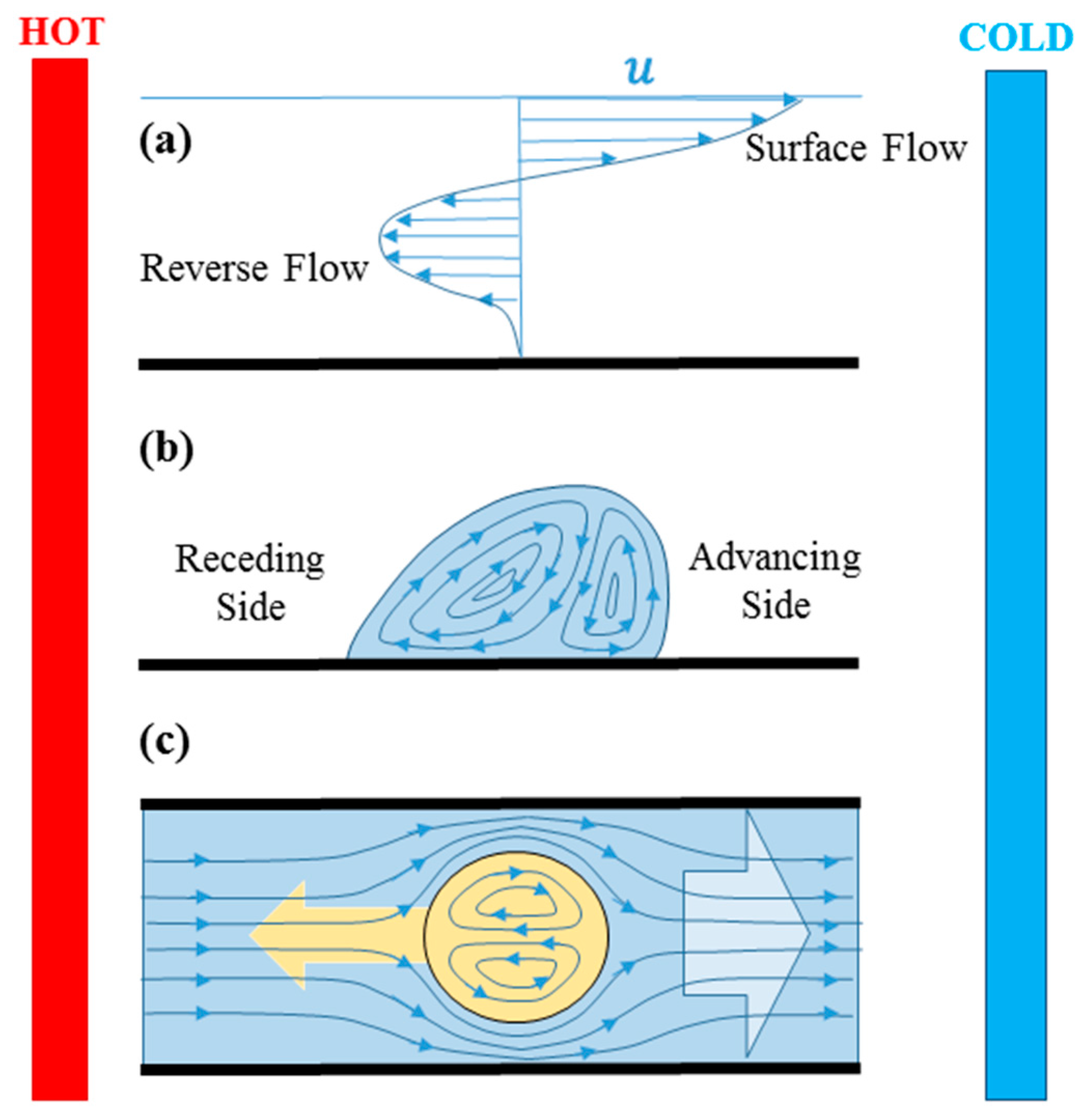
2. Theory
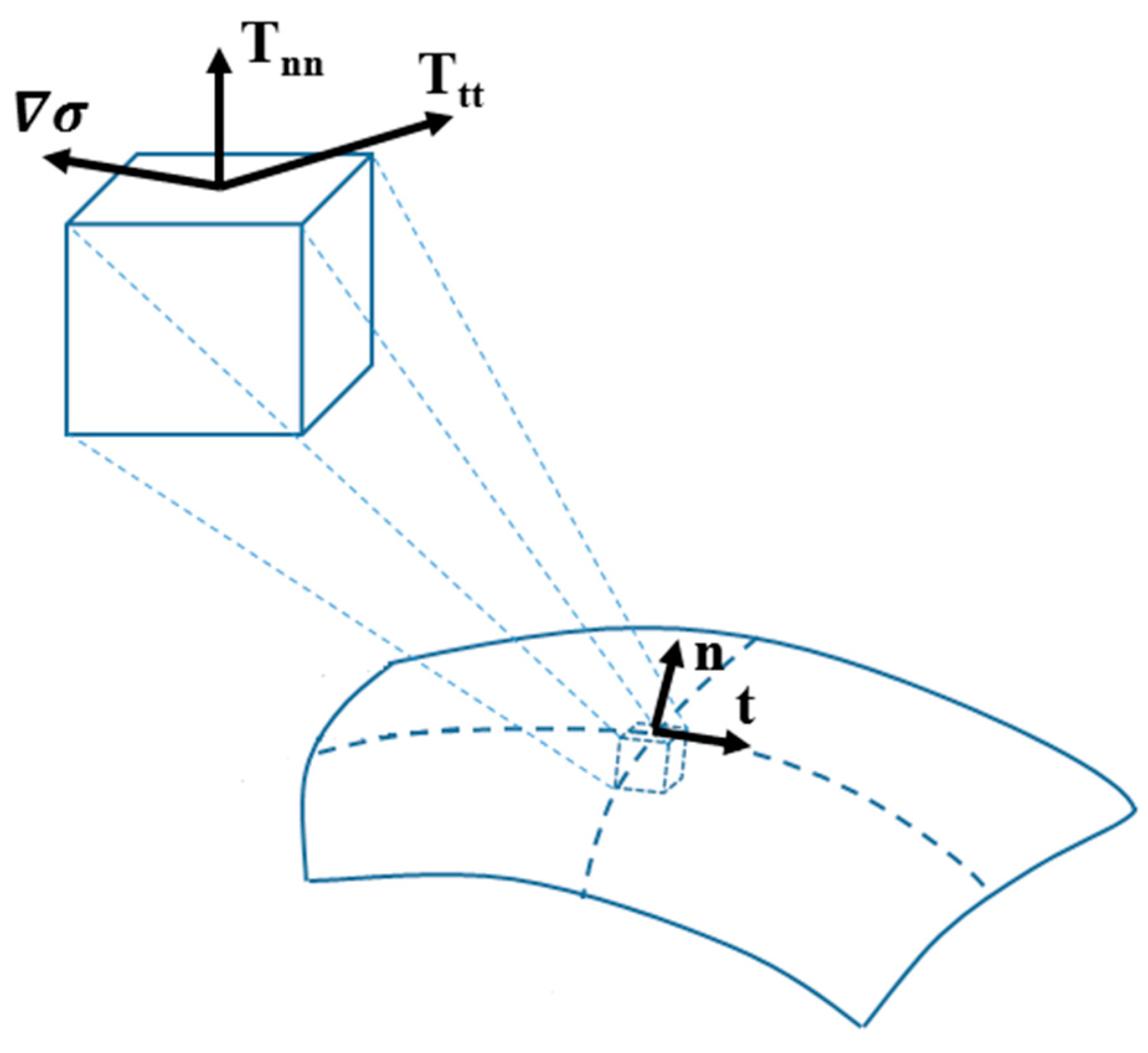
- The normal component of the hydrodynamic stresses must balance with the portion of surface tension due to curvature (Equation (1)). This equation is called Laplace equation in the absence of viscosity.
- The tangential component of the hydrodynamic stresses must balance the tangential portion of the surface tension gradient (Equation (2)).
| Number | Symbol | Definition |
|---|---|---|
| Capillary Number | Ca | |
| Marangoni Number | Ma | |
| Reynold Number | Re | |
| Weber Number | We | |
| Bond Number | Bo | |
| Ohnesorge Number | Oh | |
| Froude Number | Fr | |
| Biot Number | Bi | |
| Nusselt Number * | Nu | |
| Prandtl Number | Pr | |
| Peclet Number * | Pe |
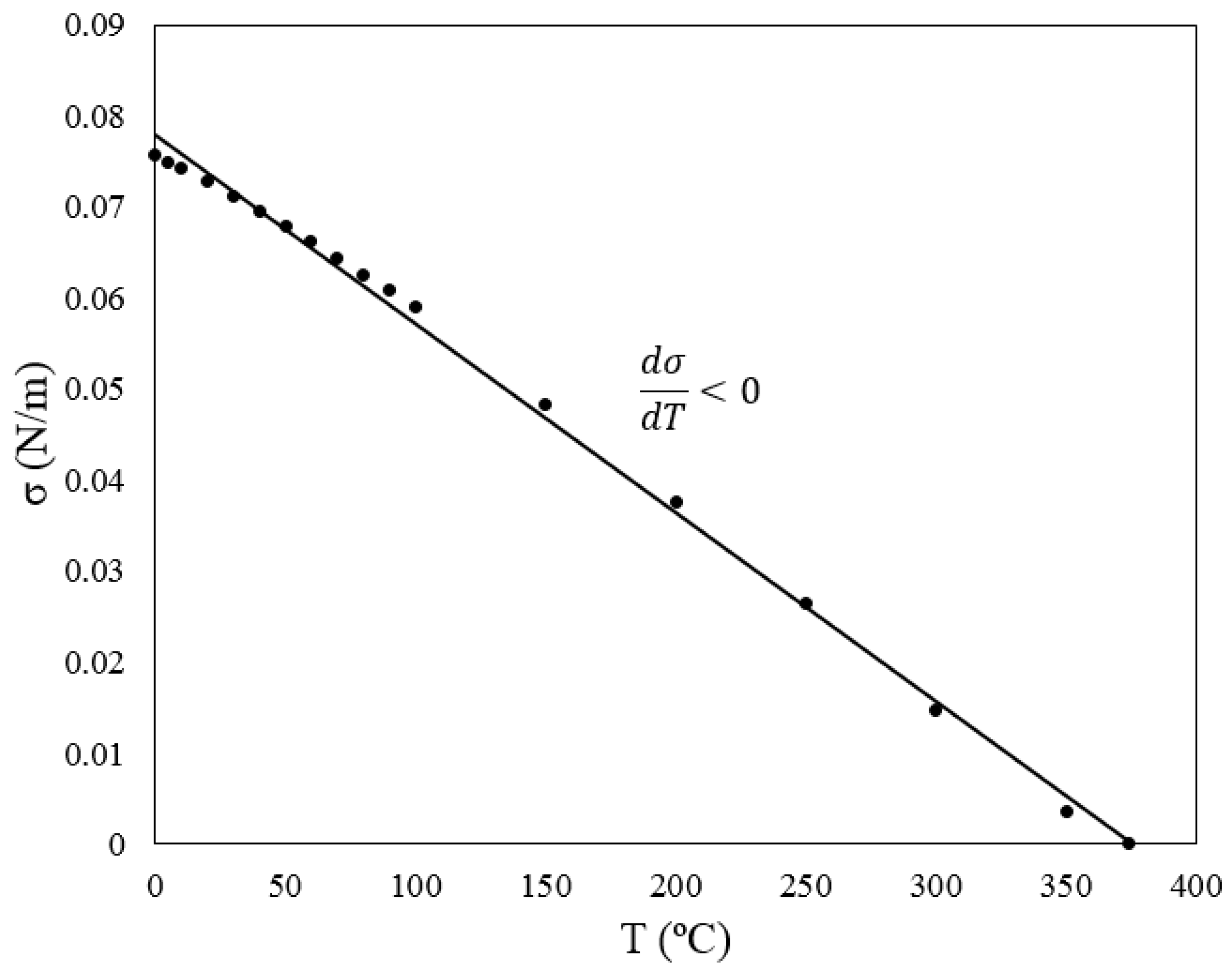
3. Thermocapillary Instability of Thin Films
4. Thermocapillary Effects in Evaporating Droplets
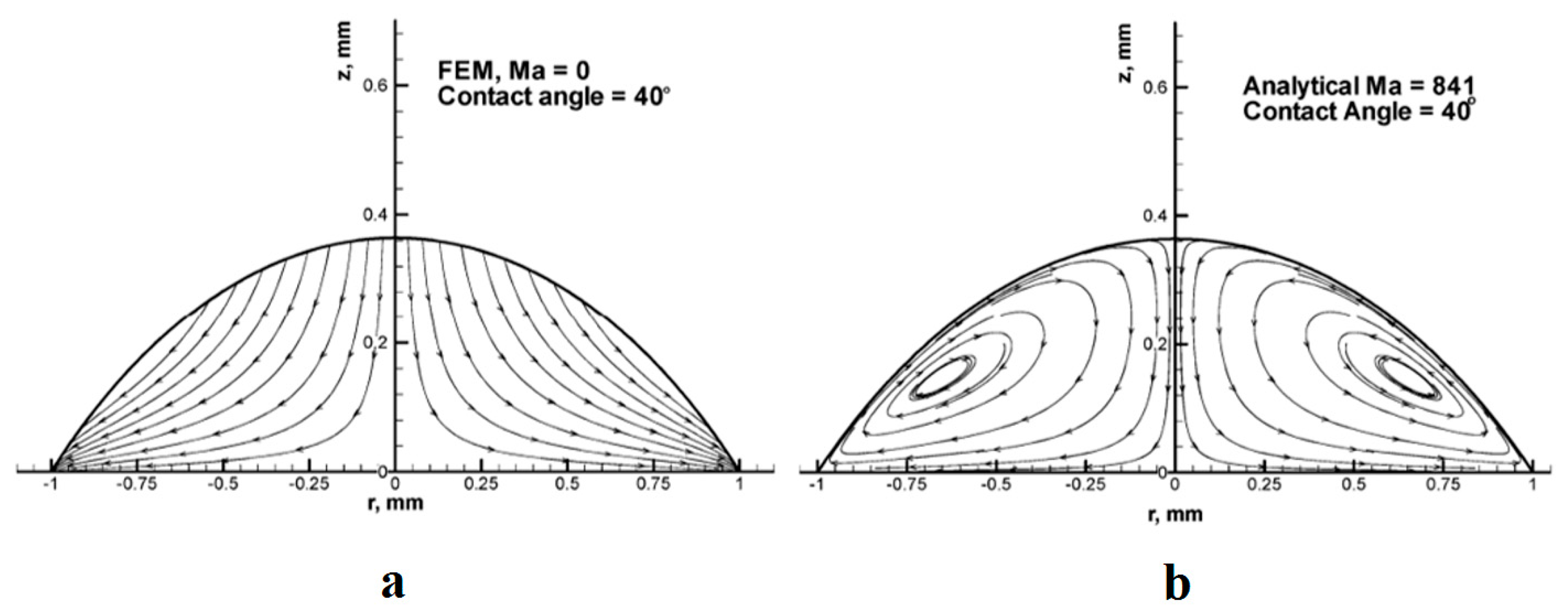
5. Thermocapillary-Induced Droplet/Bubble Actuation
5.1. Droplet Spreading
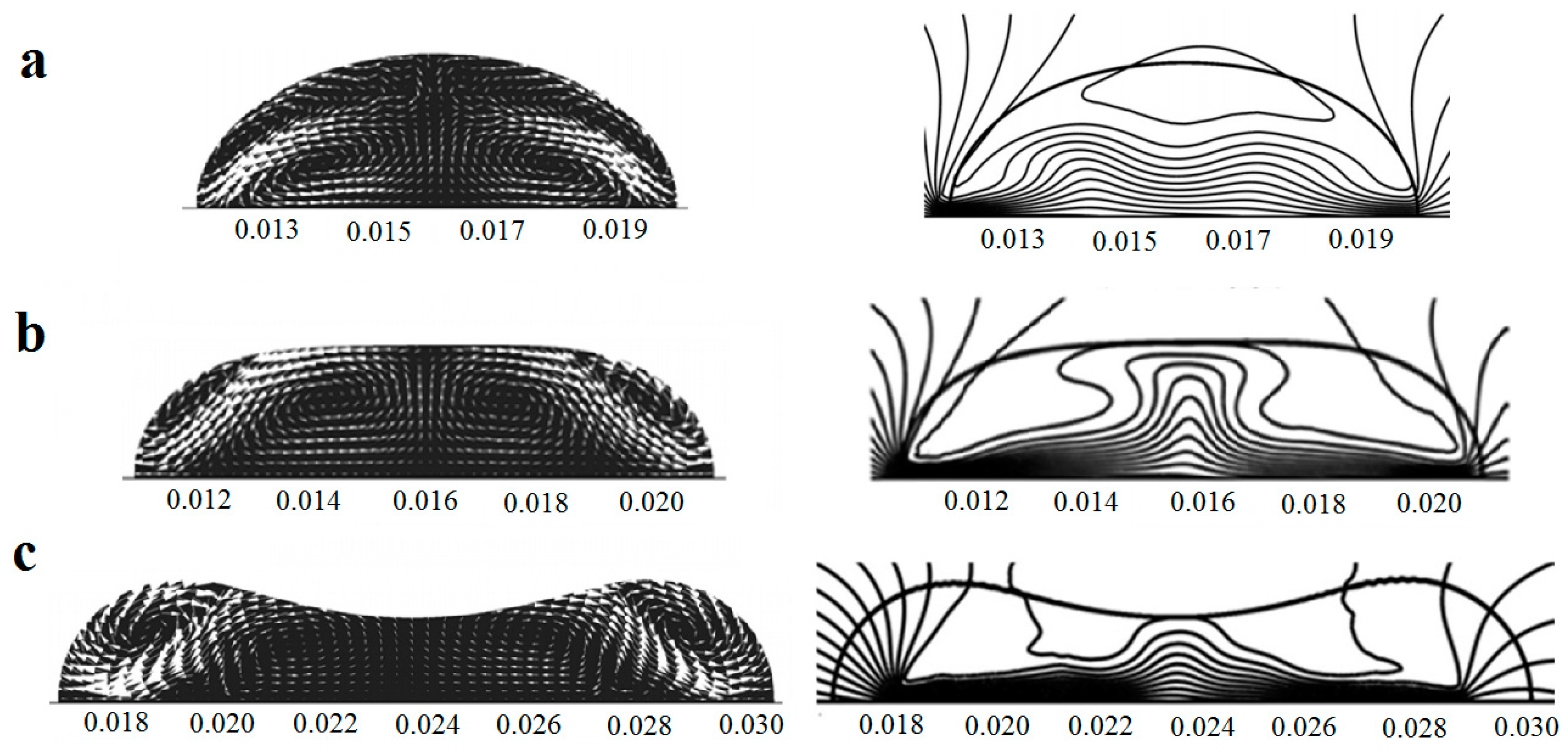
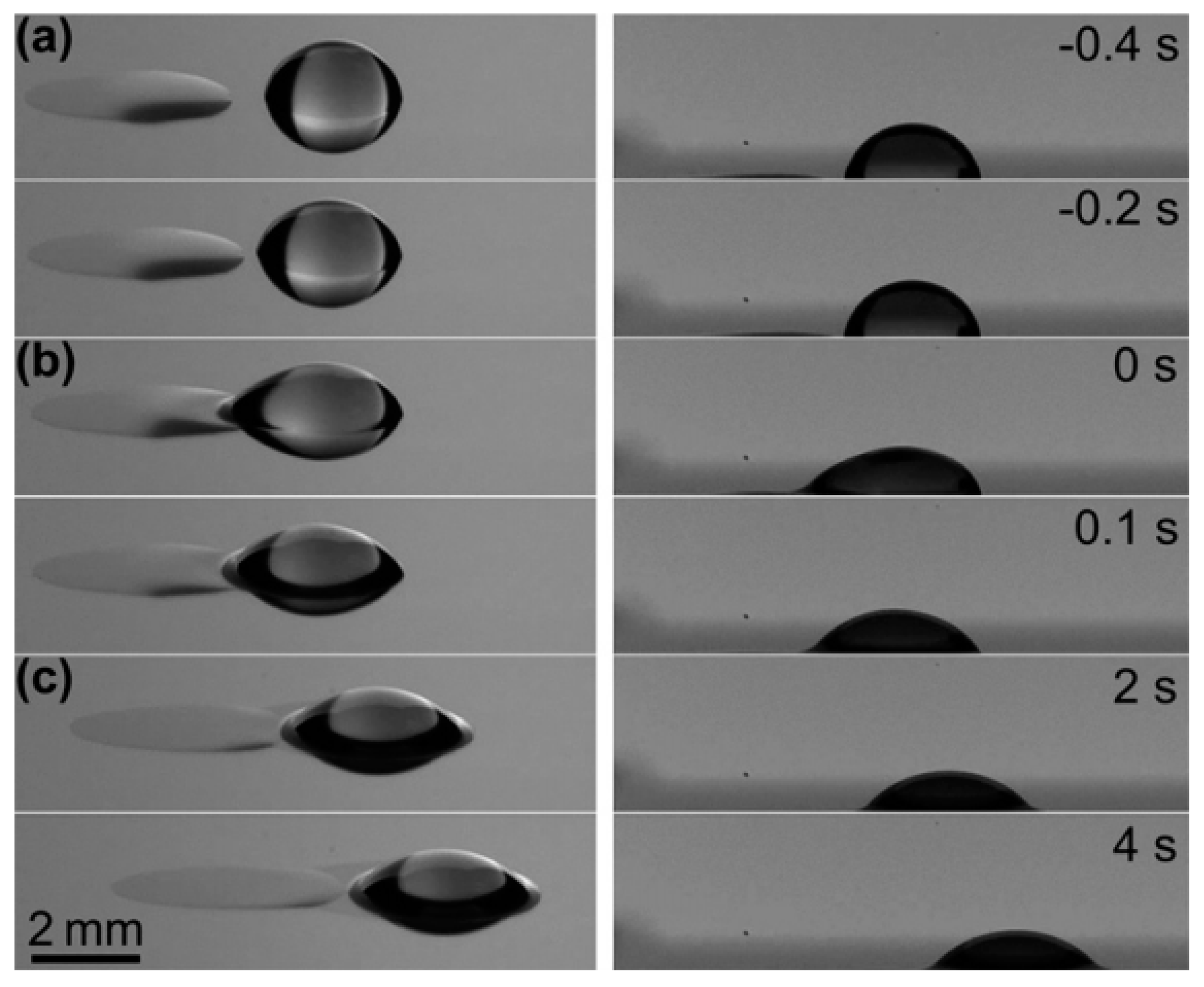
5.2. Bubble/Droplet Migration
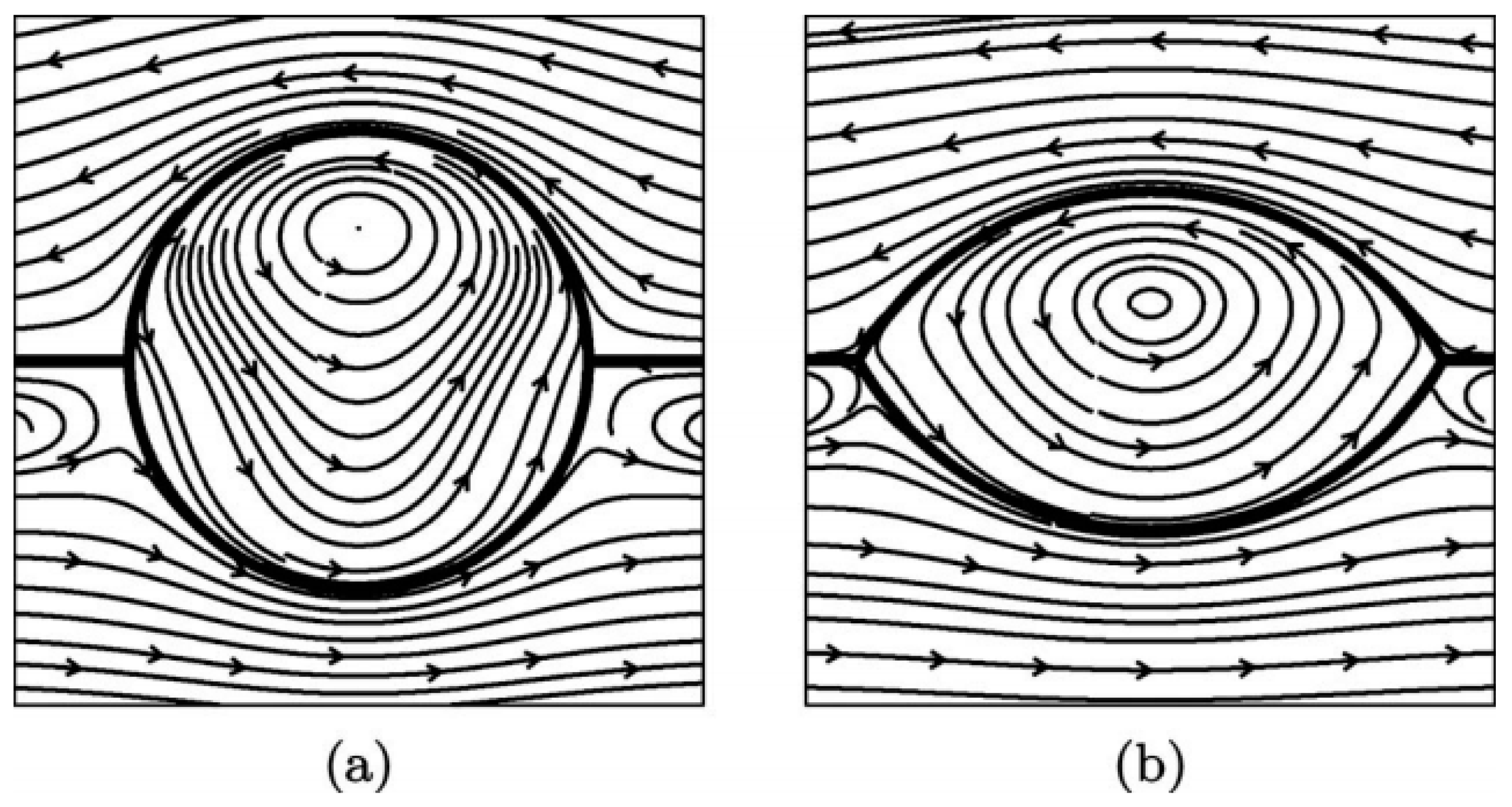
5.2.1. Mechanical Heating
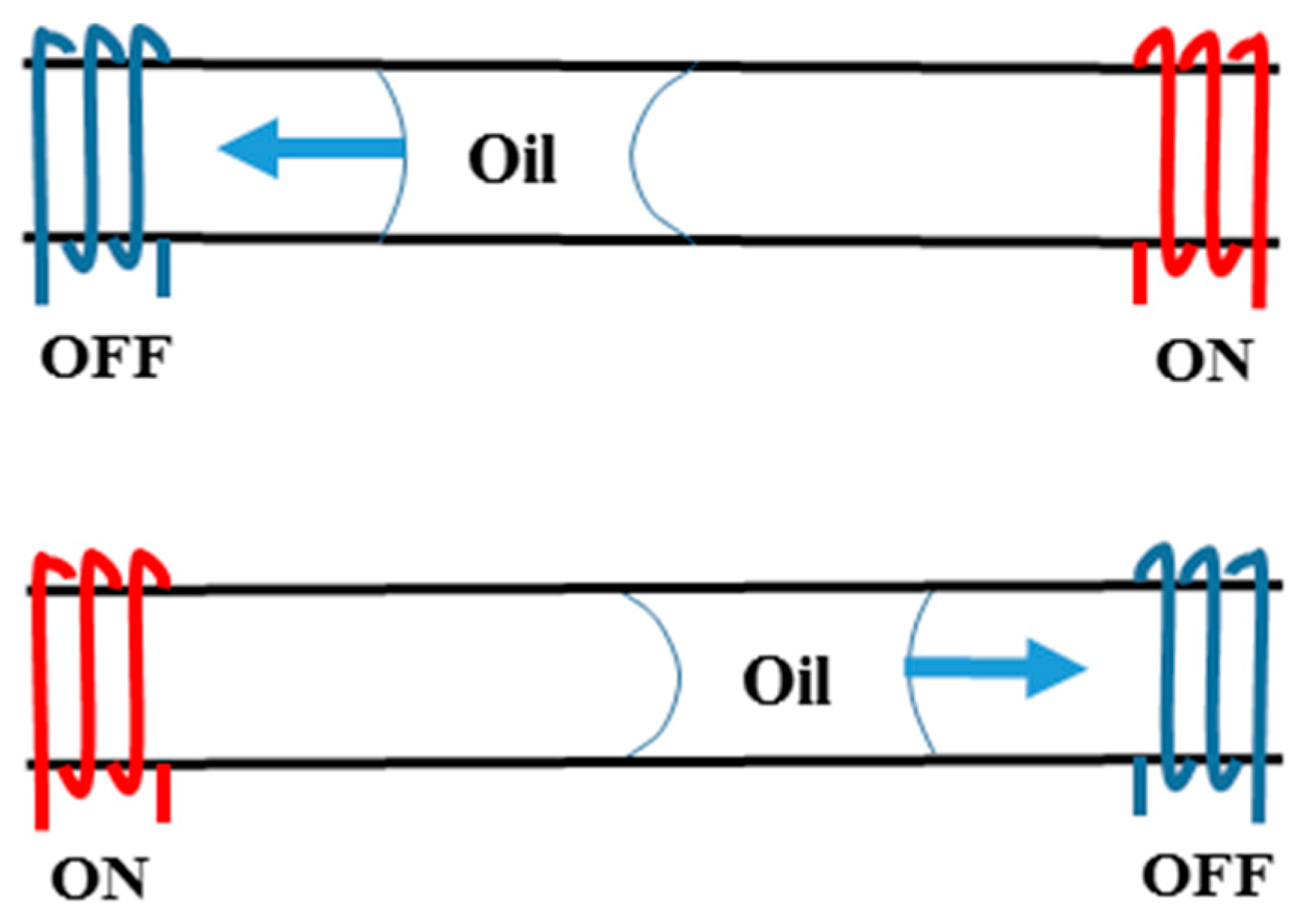

5.2.2. Optical Heating

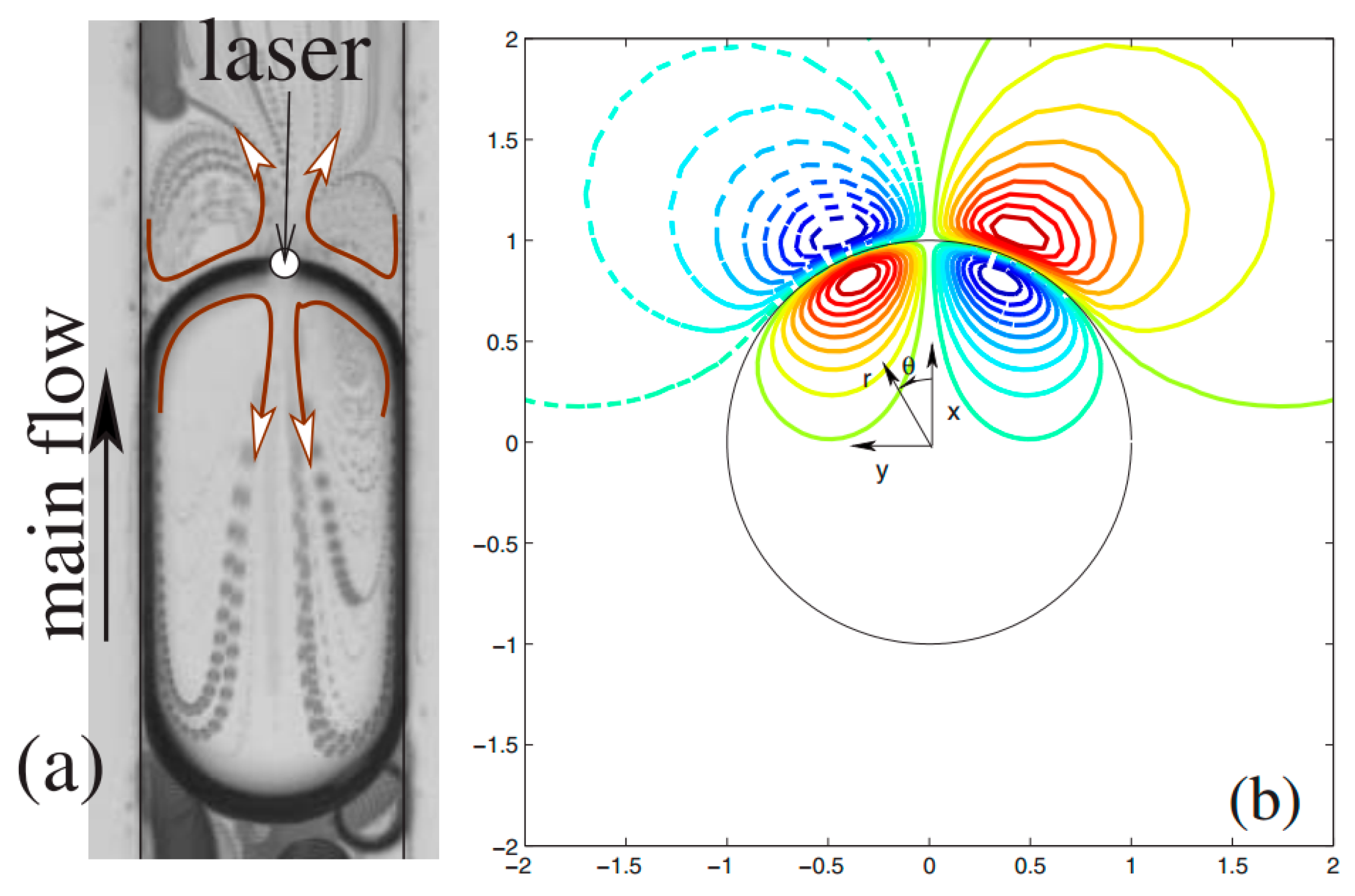
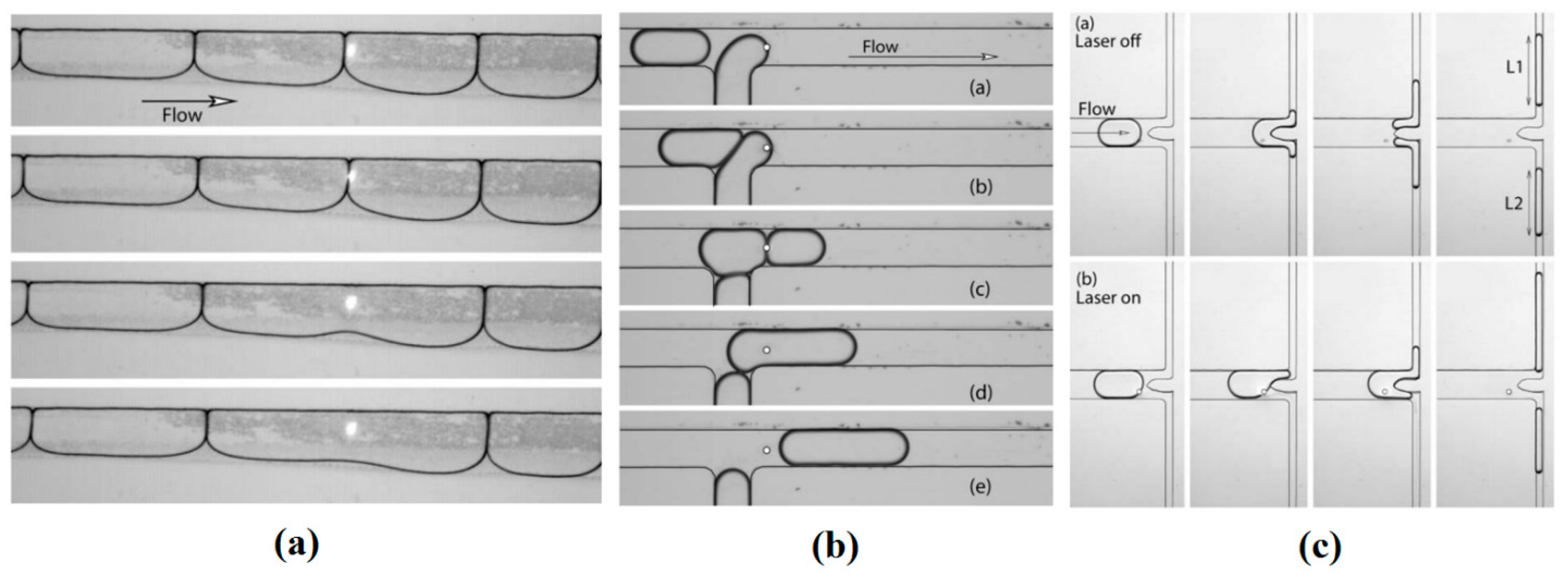
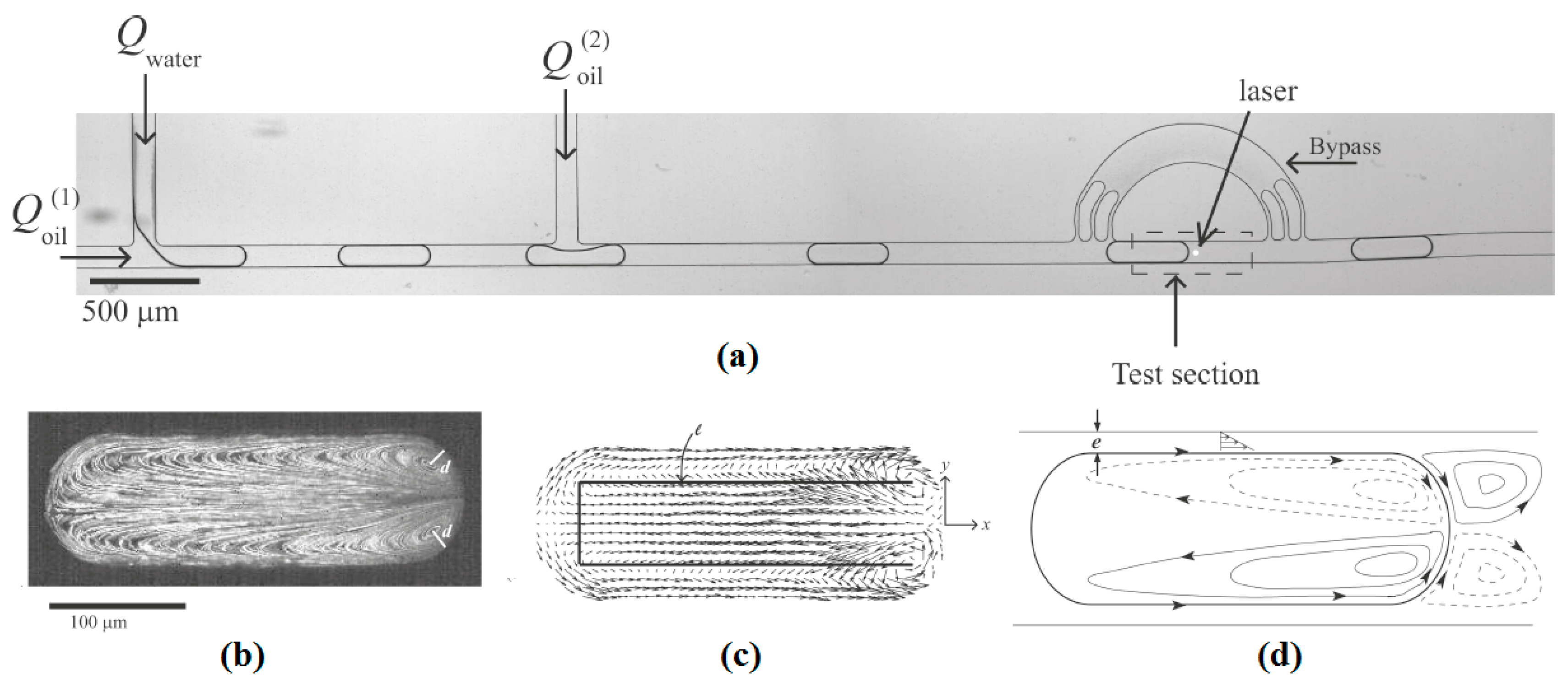
5.3. Thermocapillary Mixing
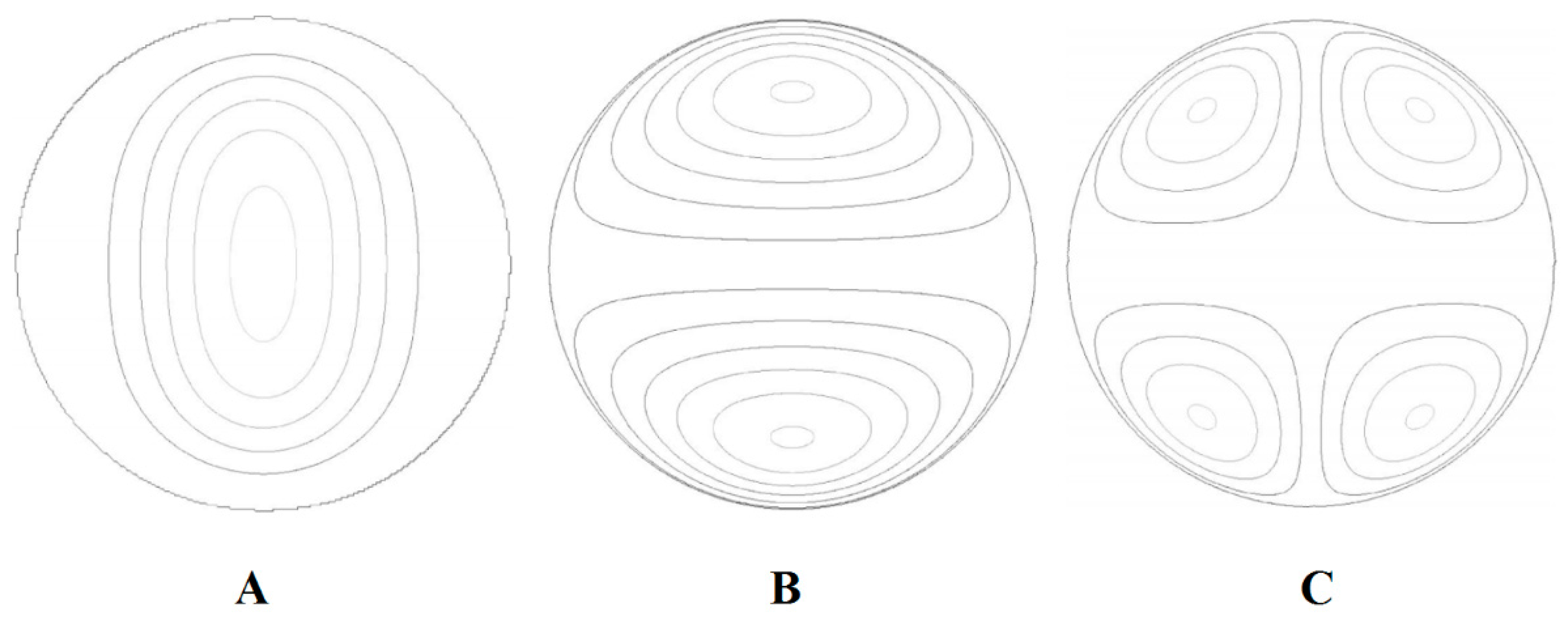
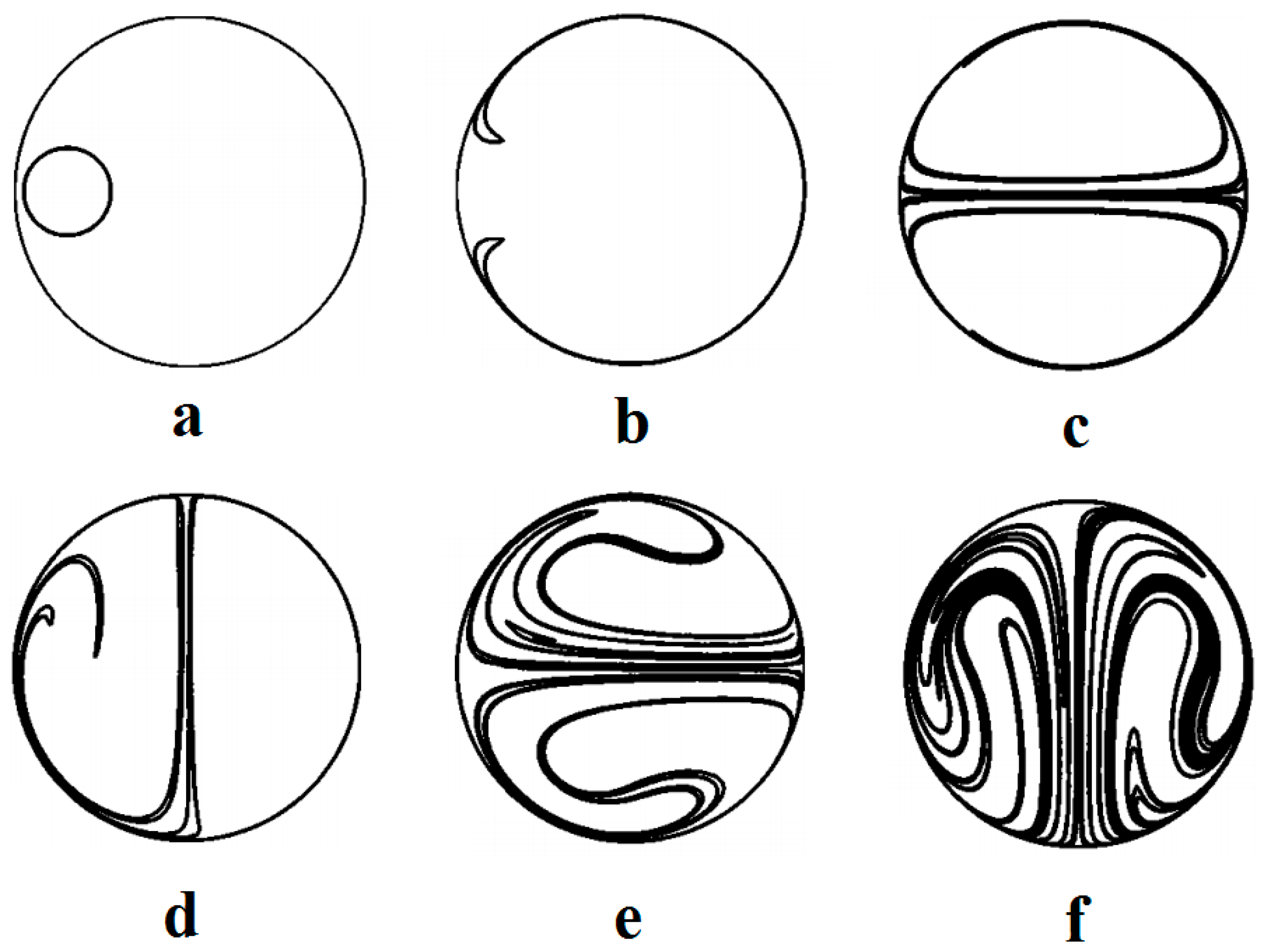
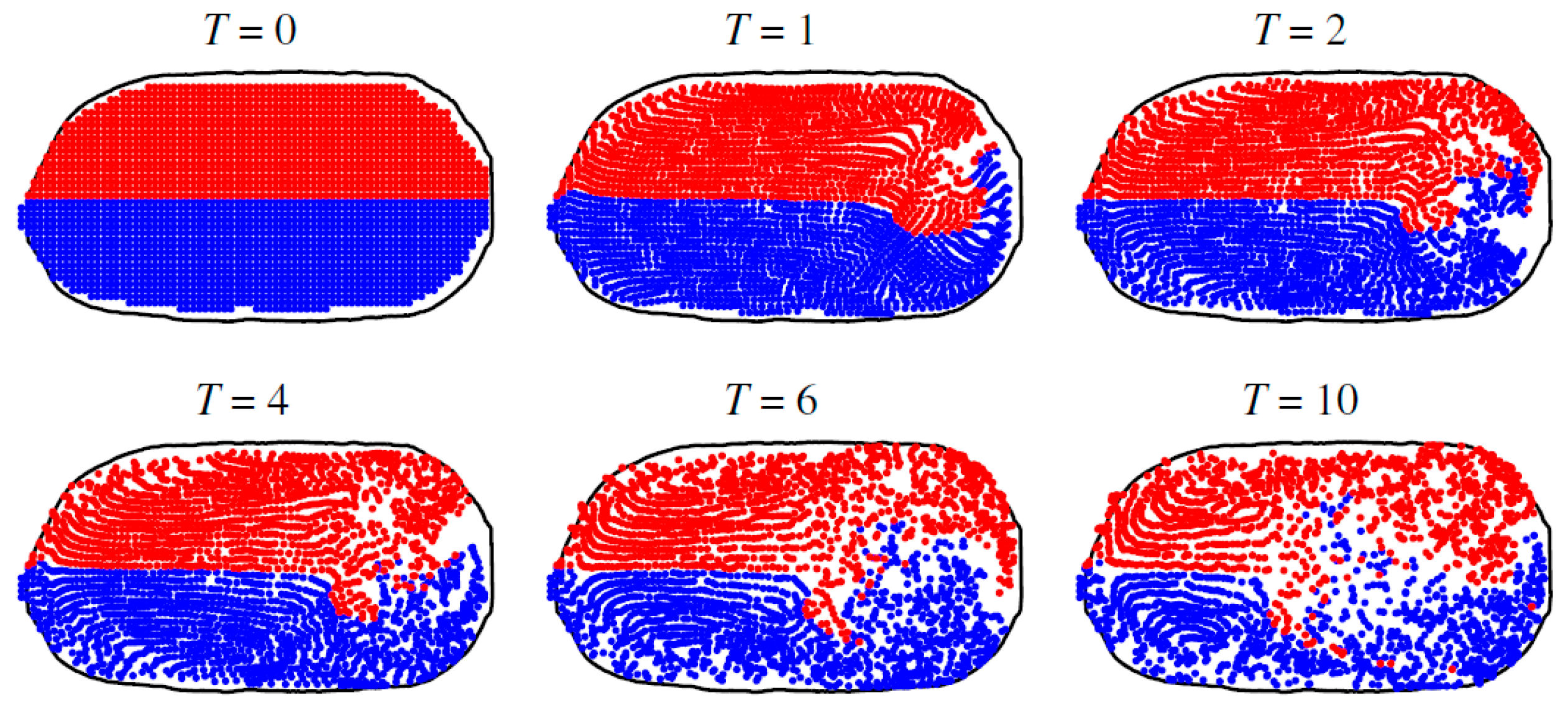
5.4. Thermocapillary Coalescence and Nonwetting
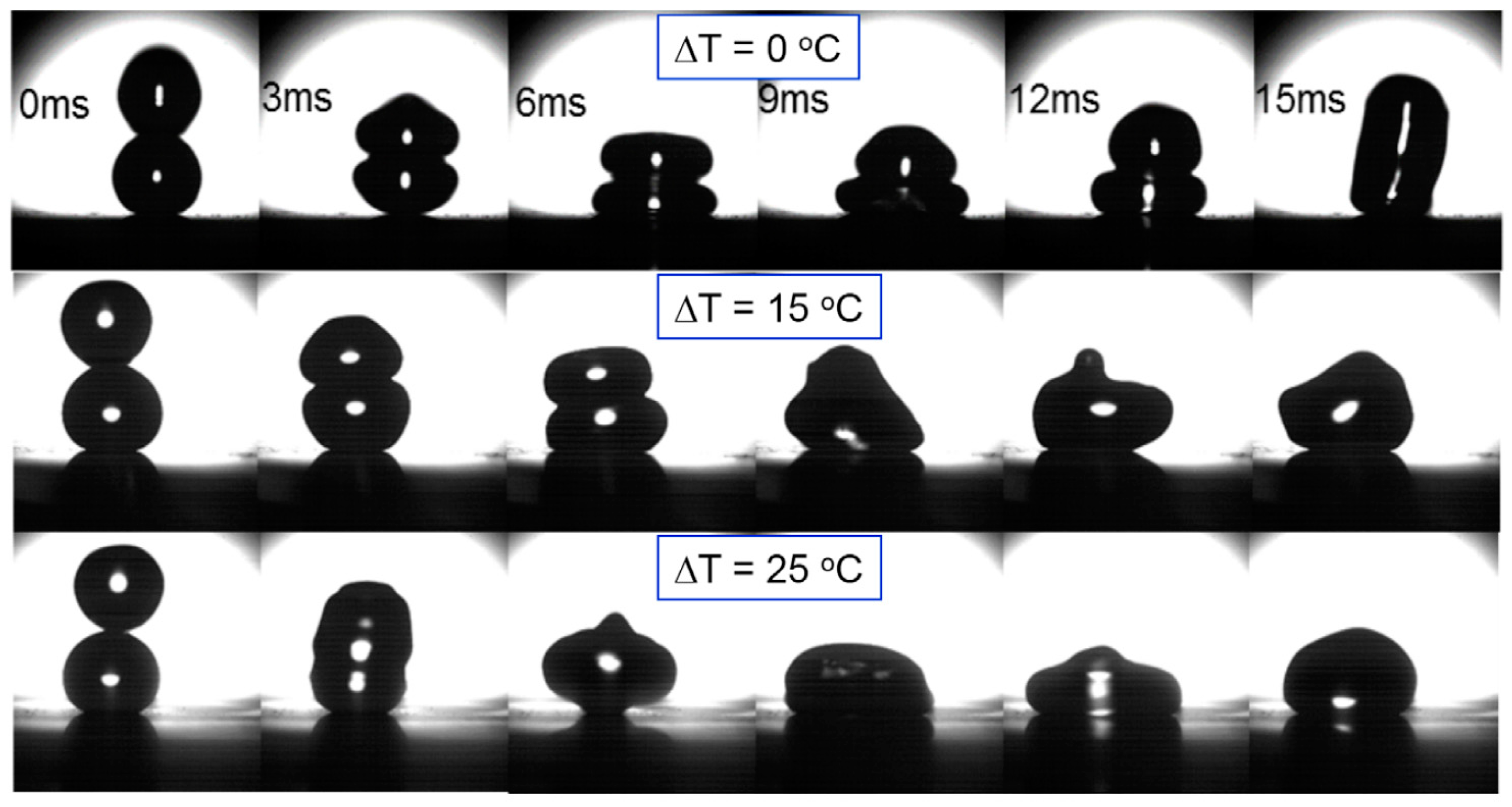
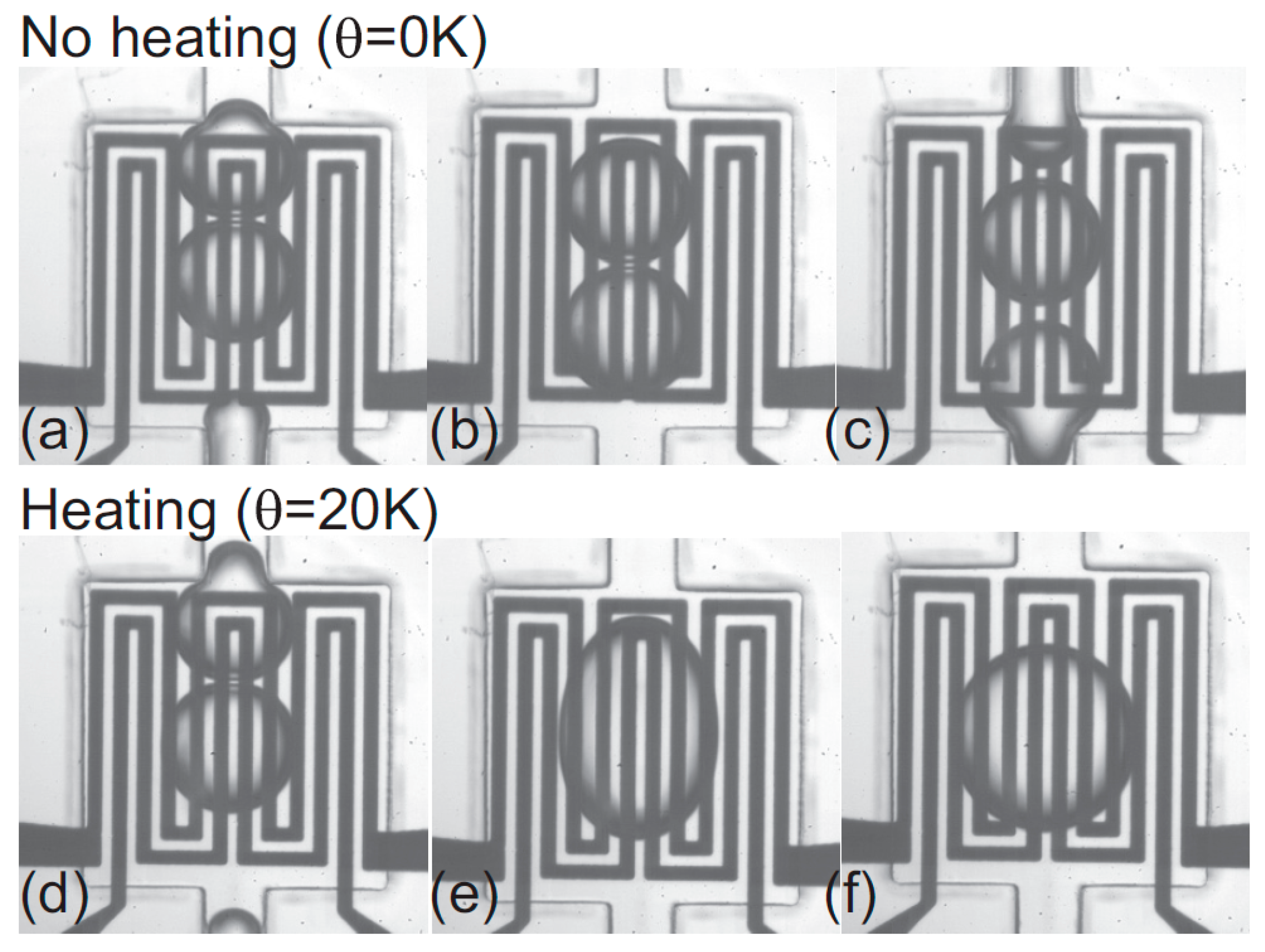
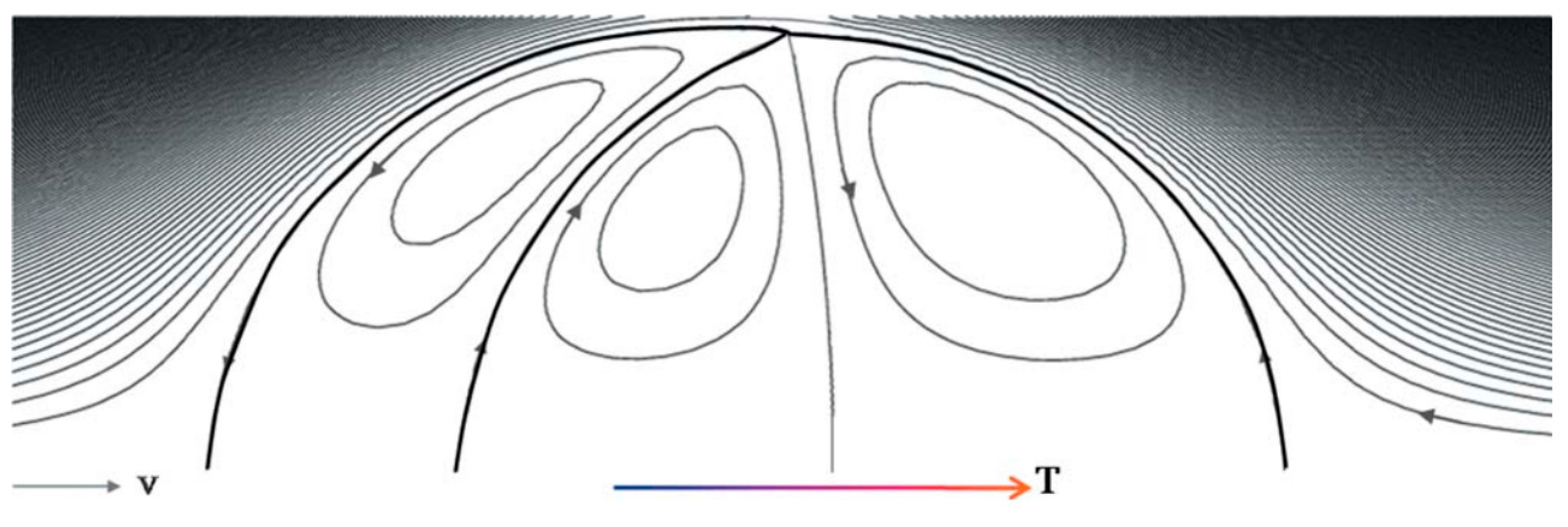

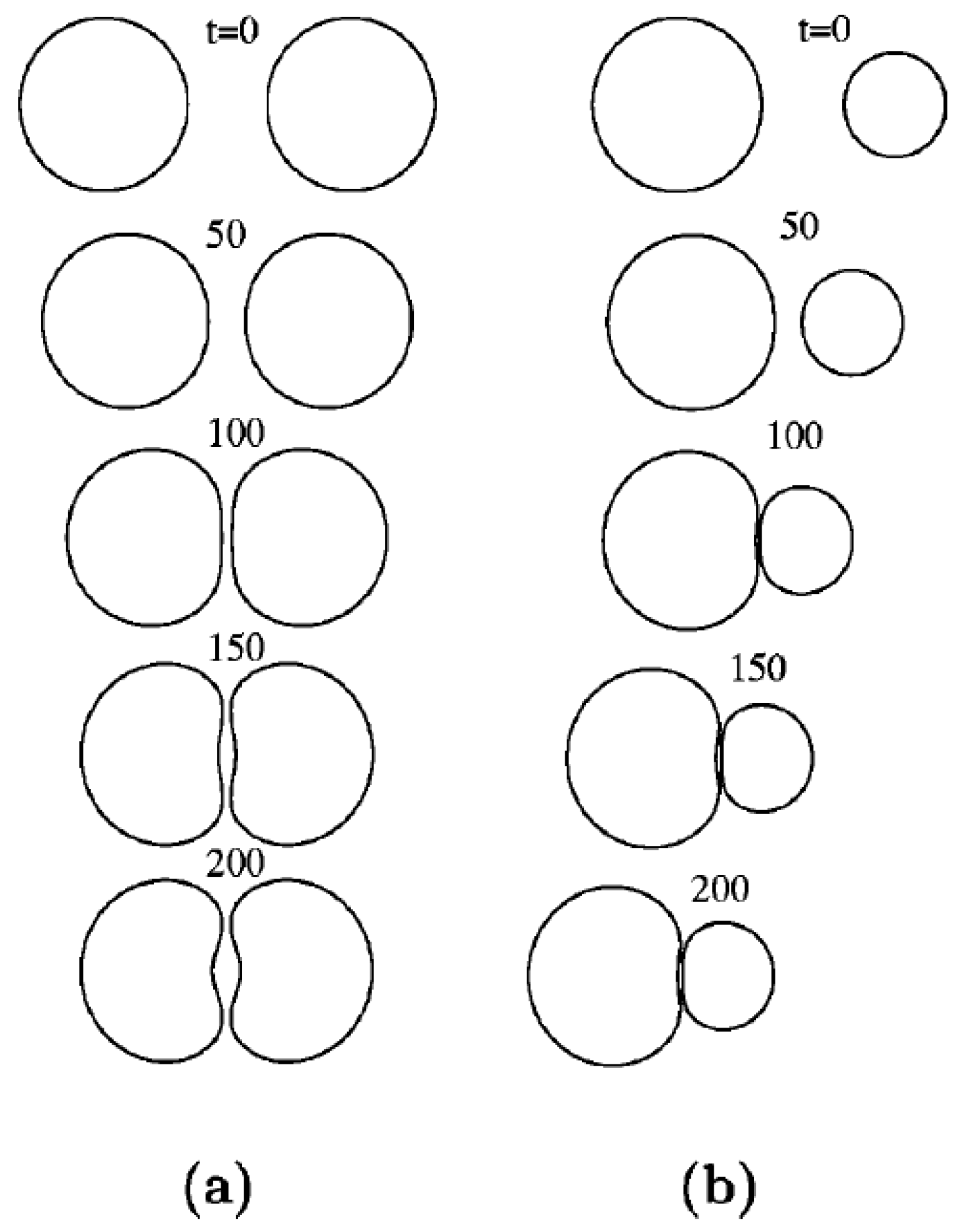
5.5. Drop Manipulation on Free Surface
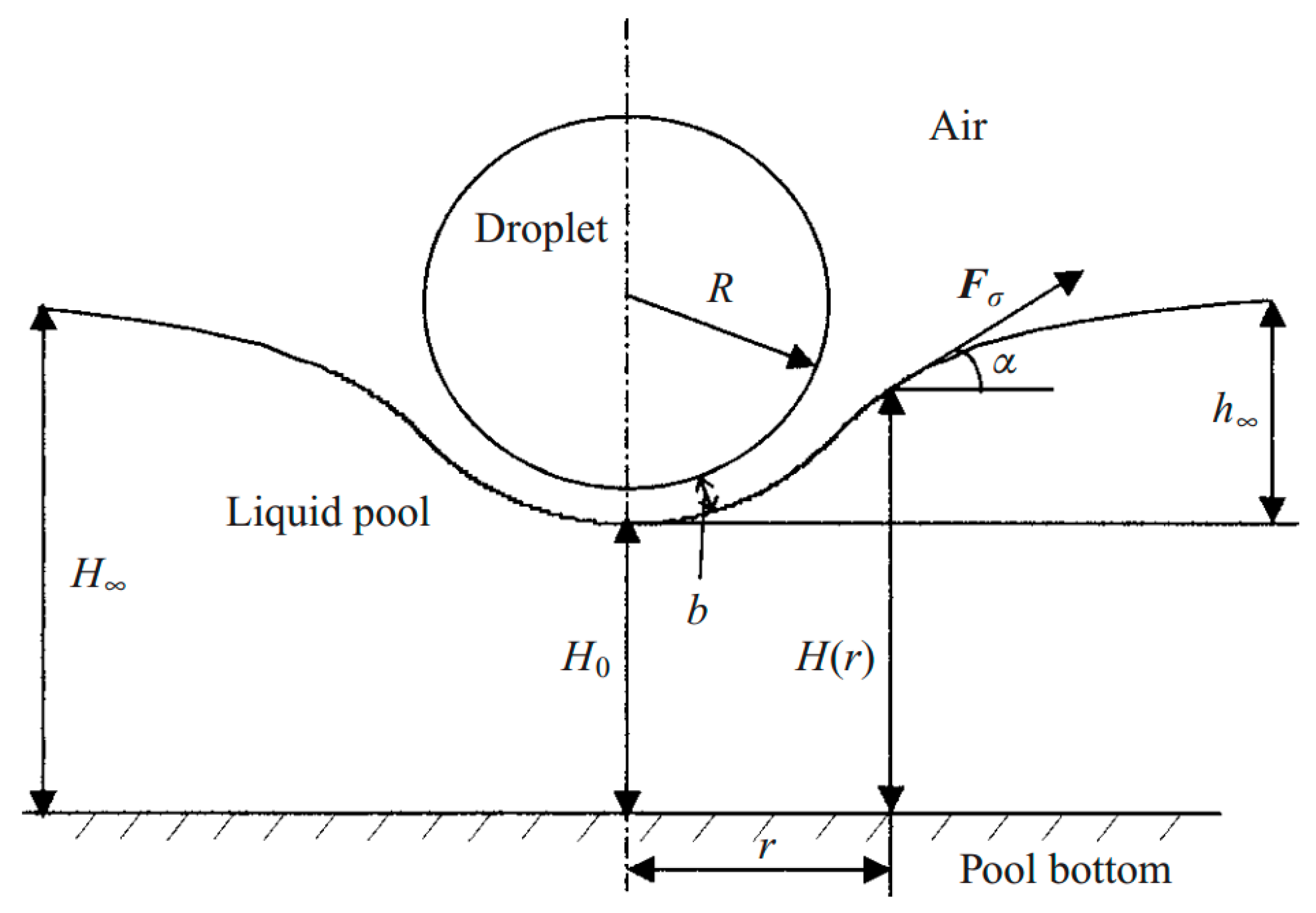
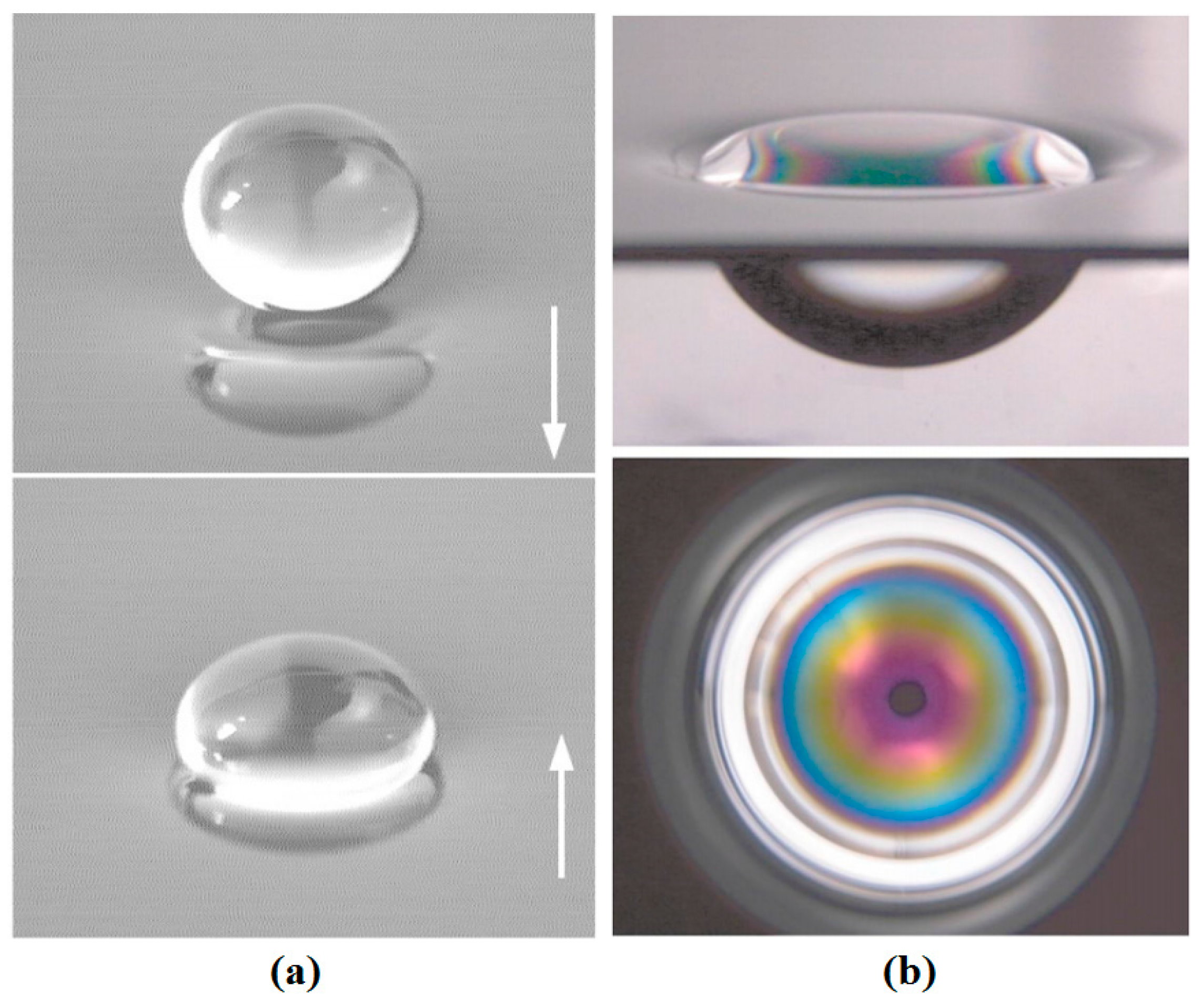

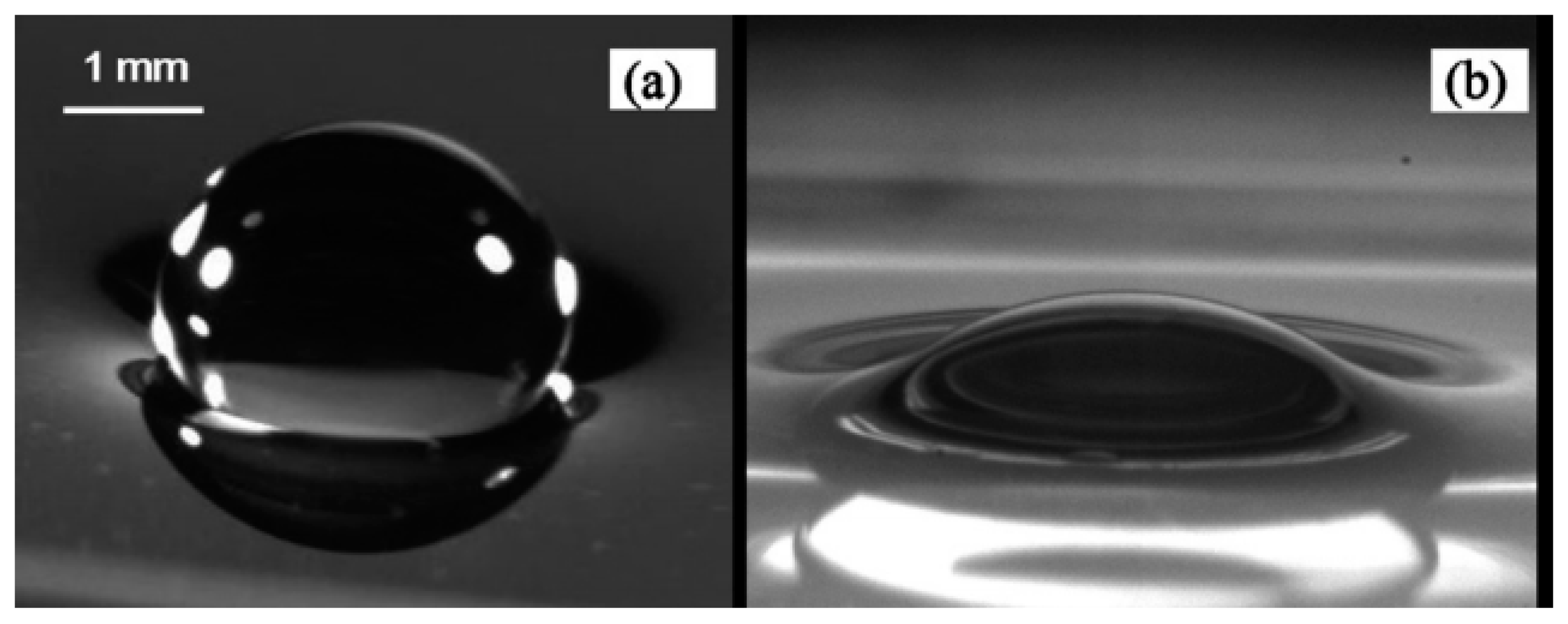

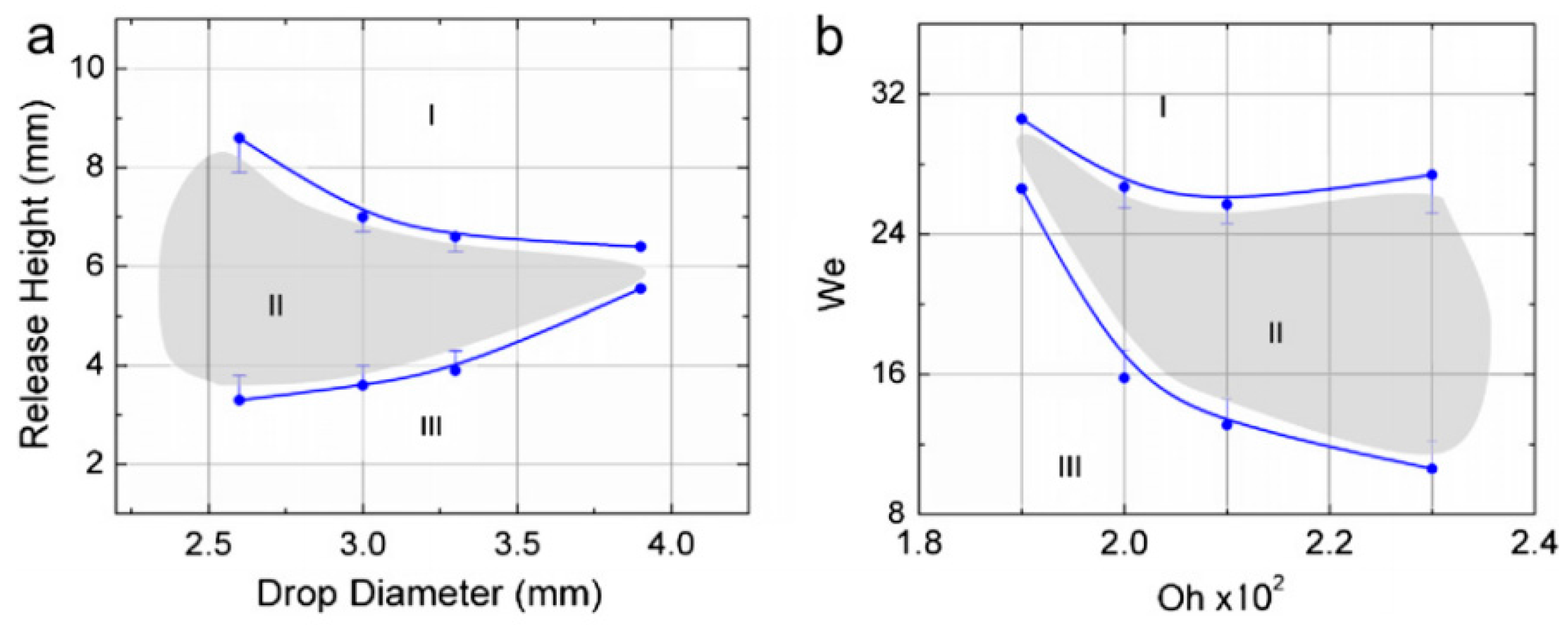
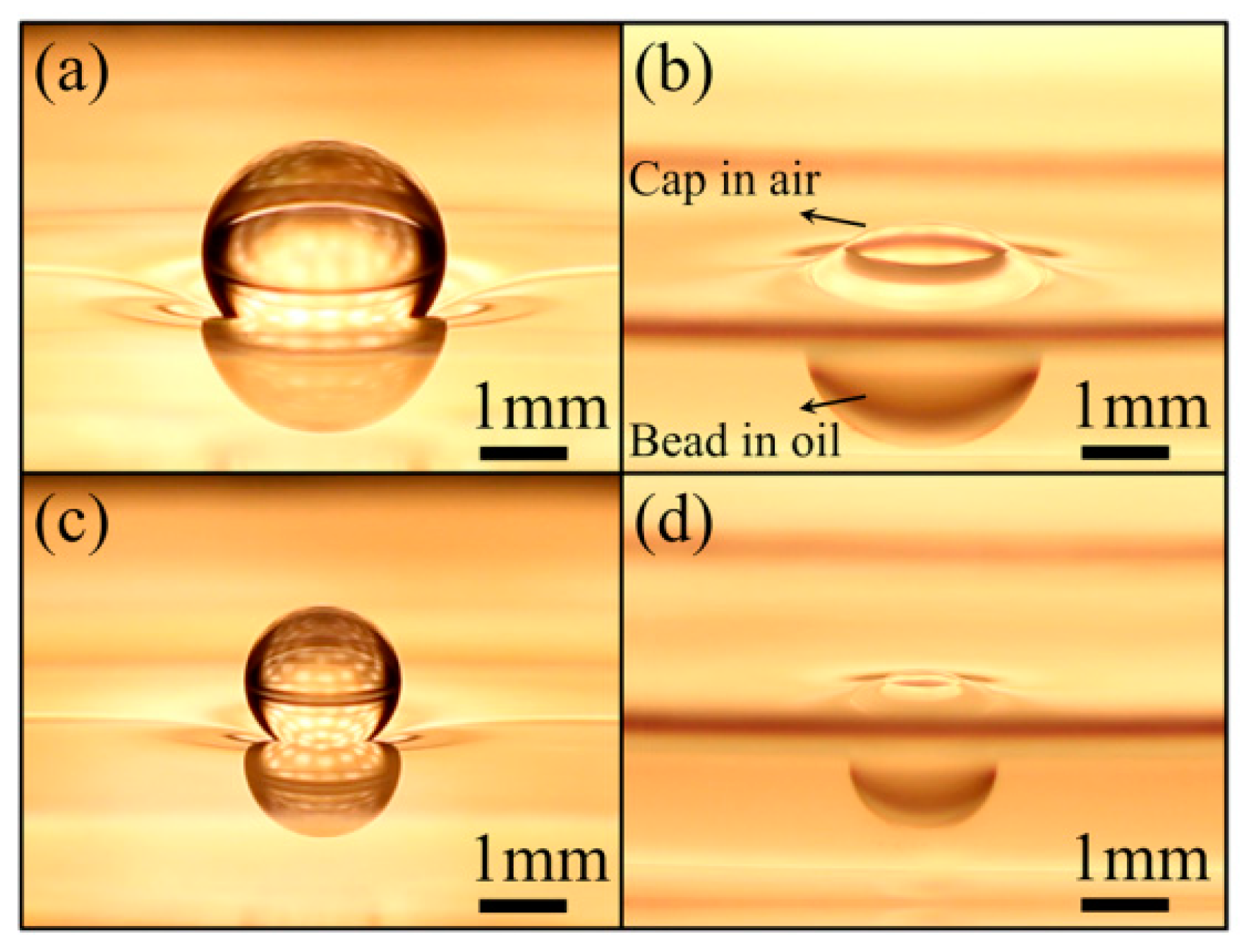
6. Device Applications
6.1. Thermocapillary Pumps, Mixers, and Actuators
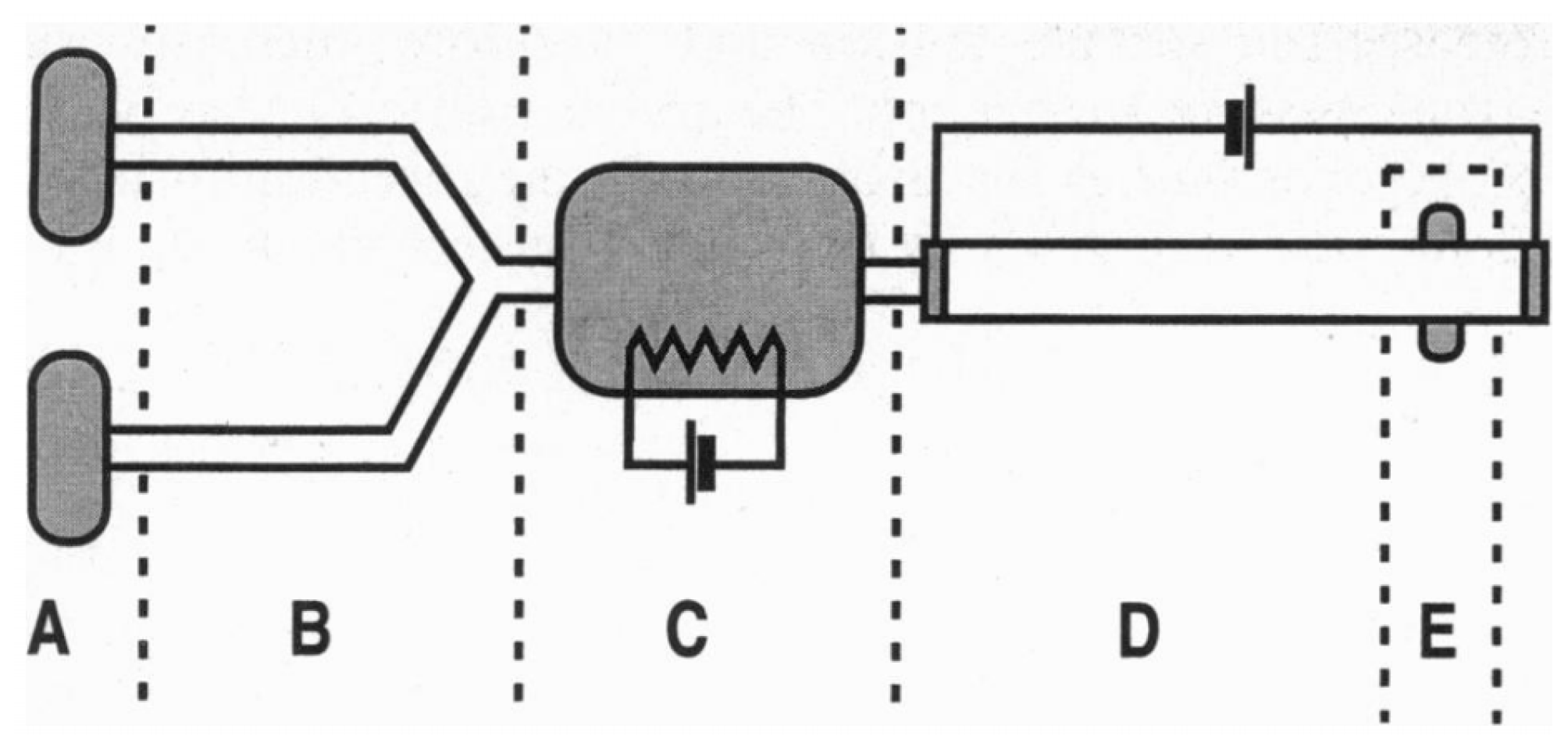
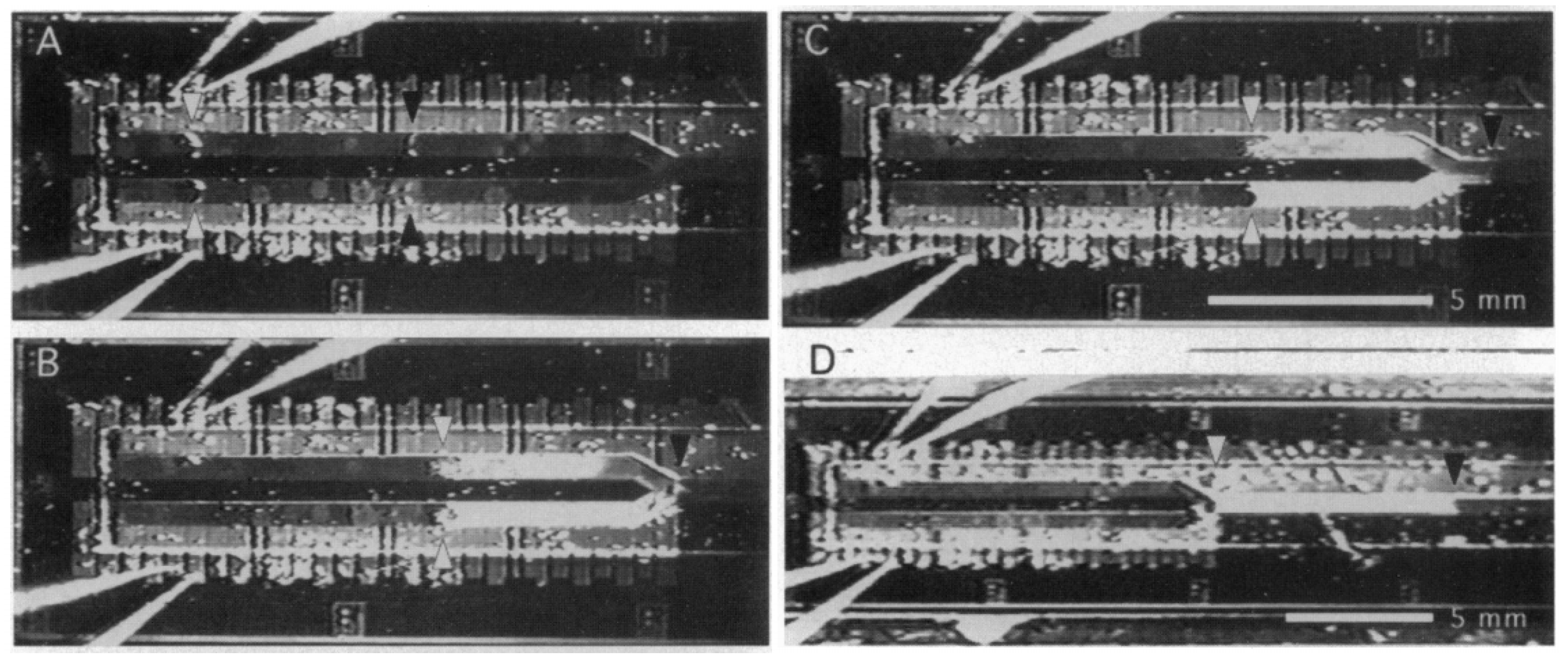
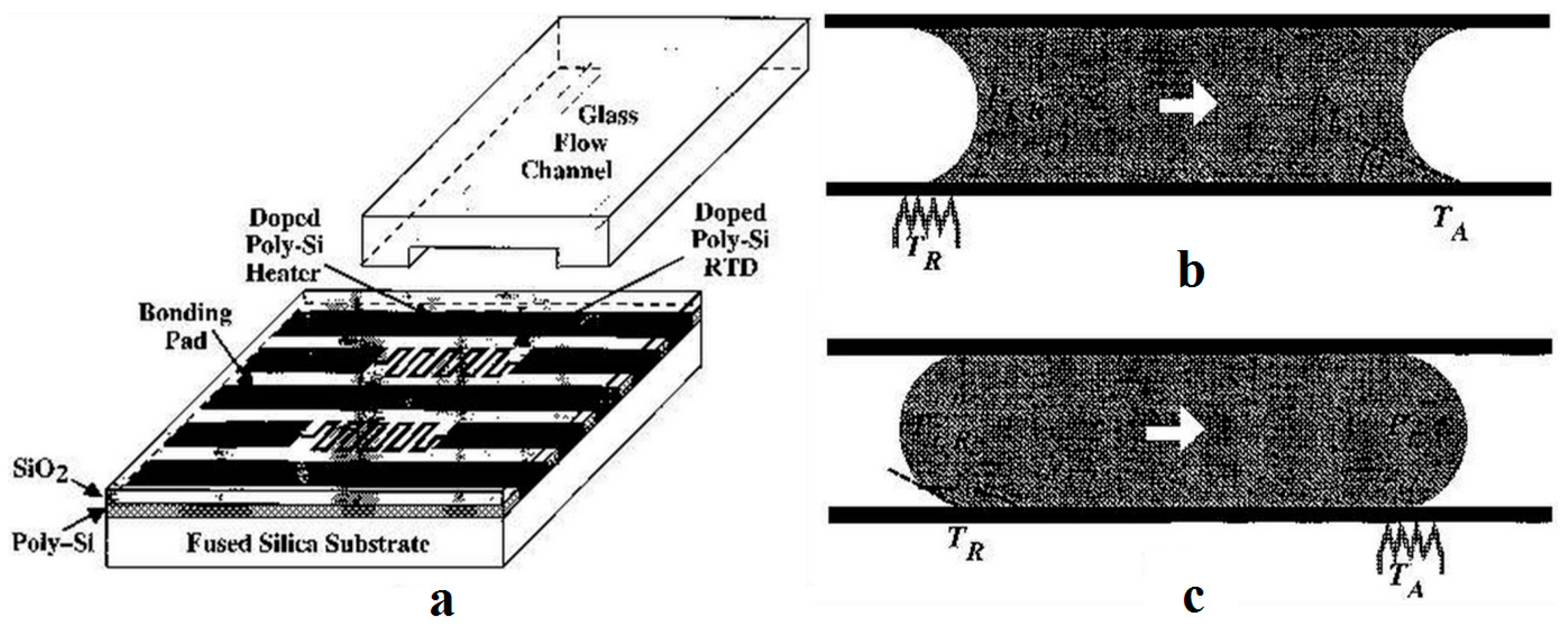

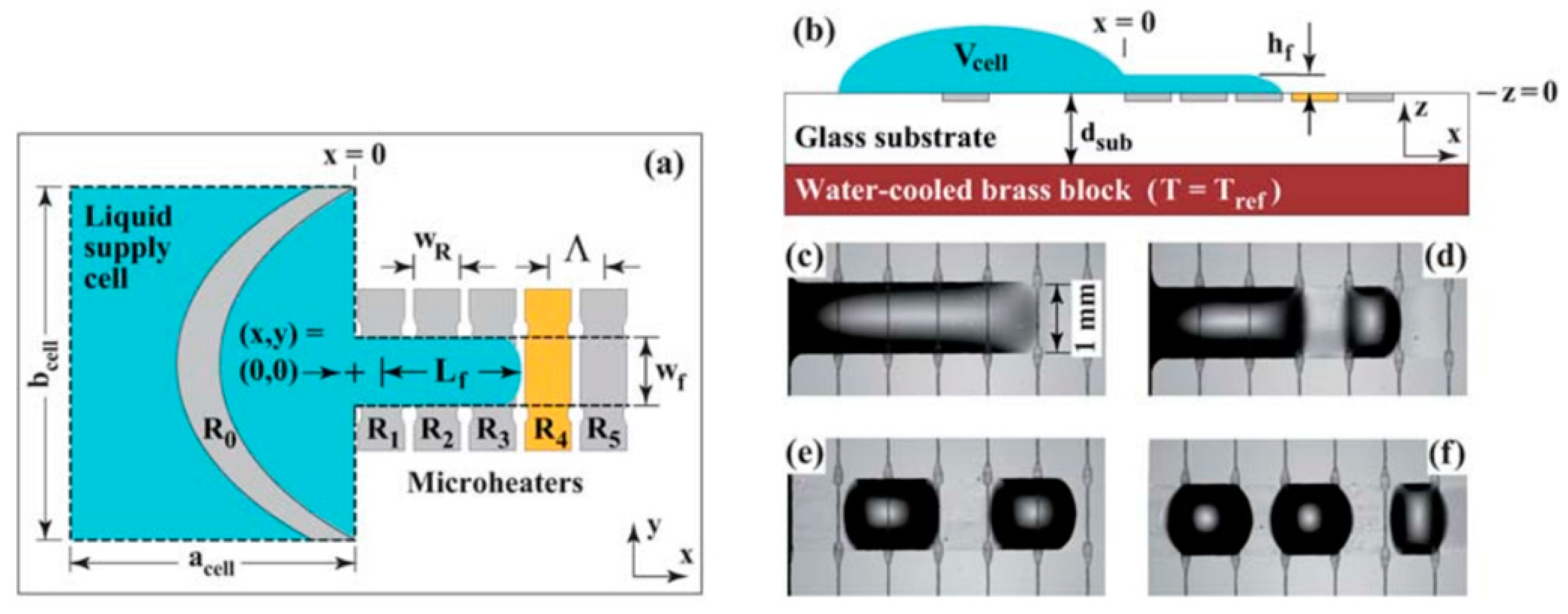
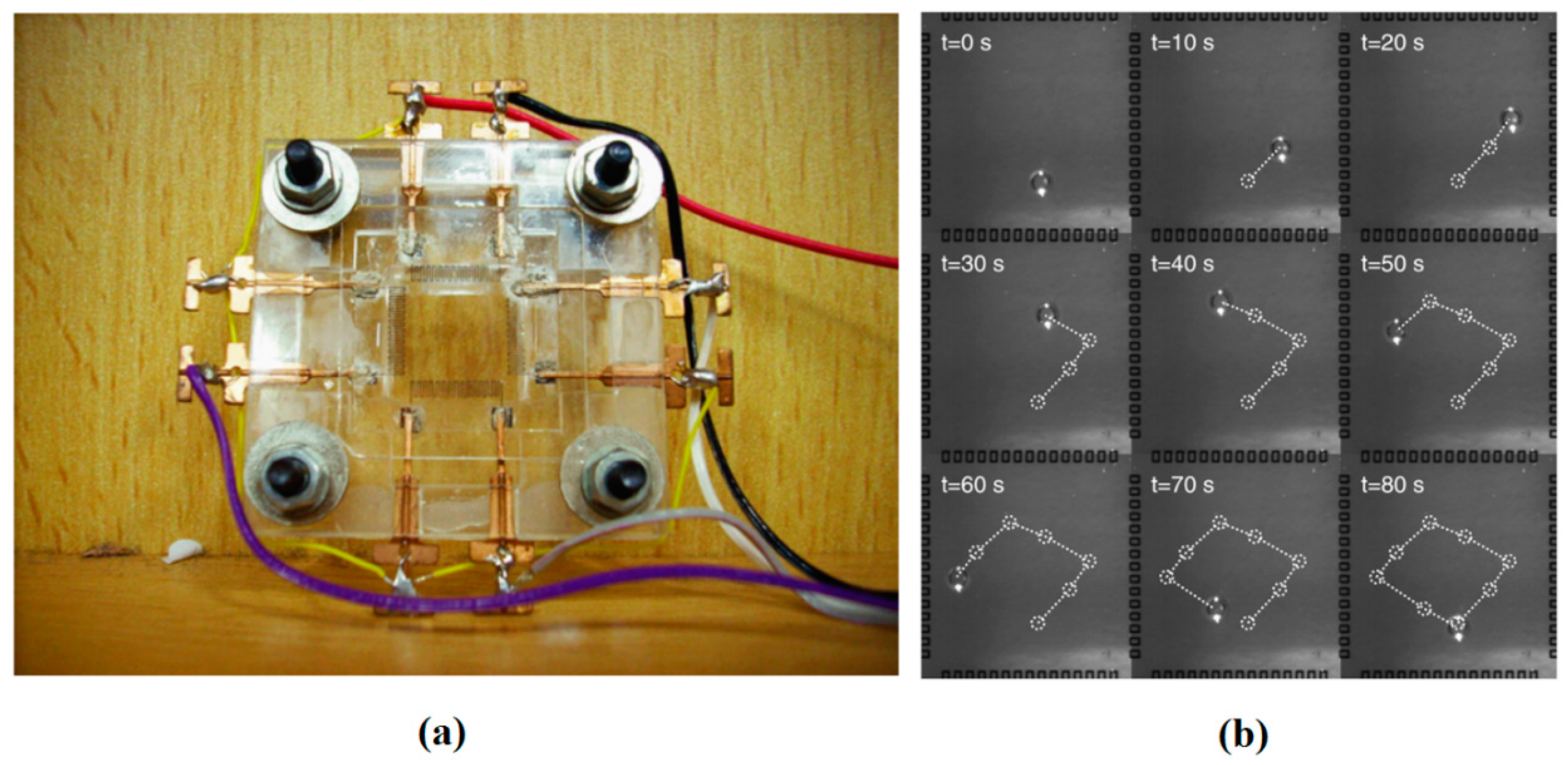
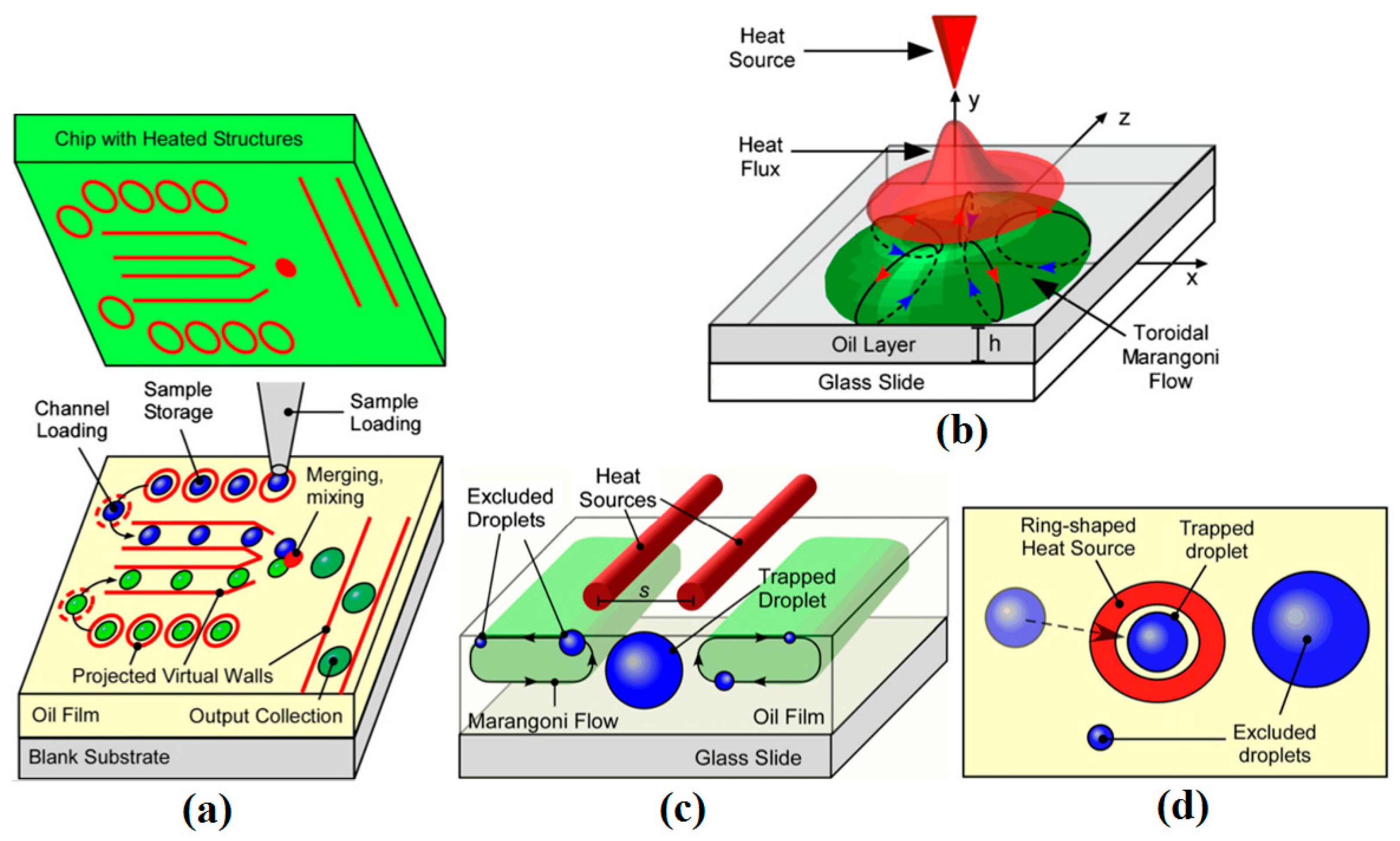
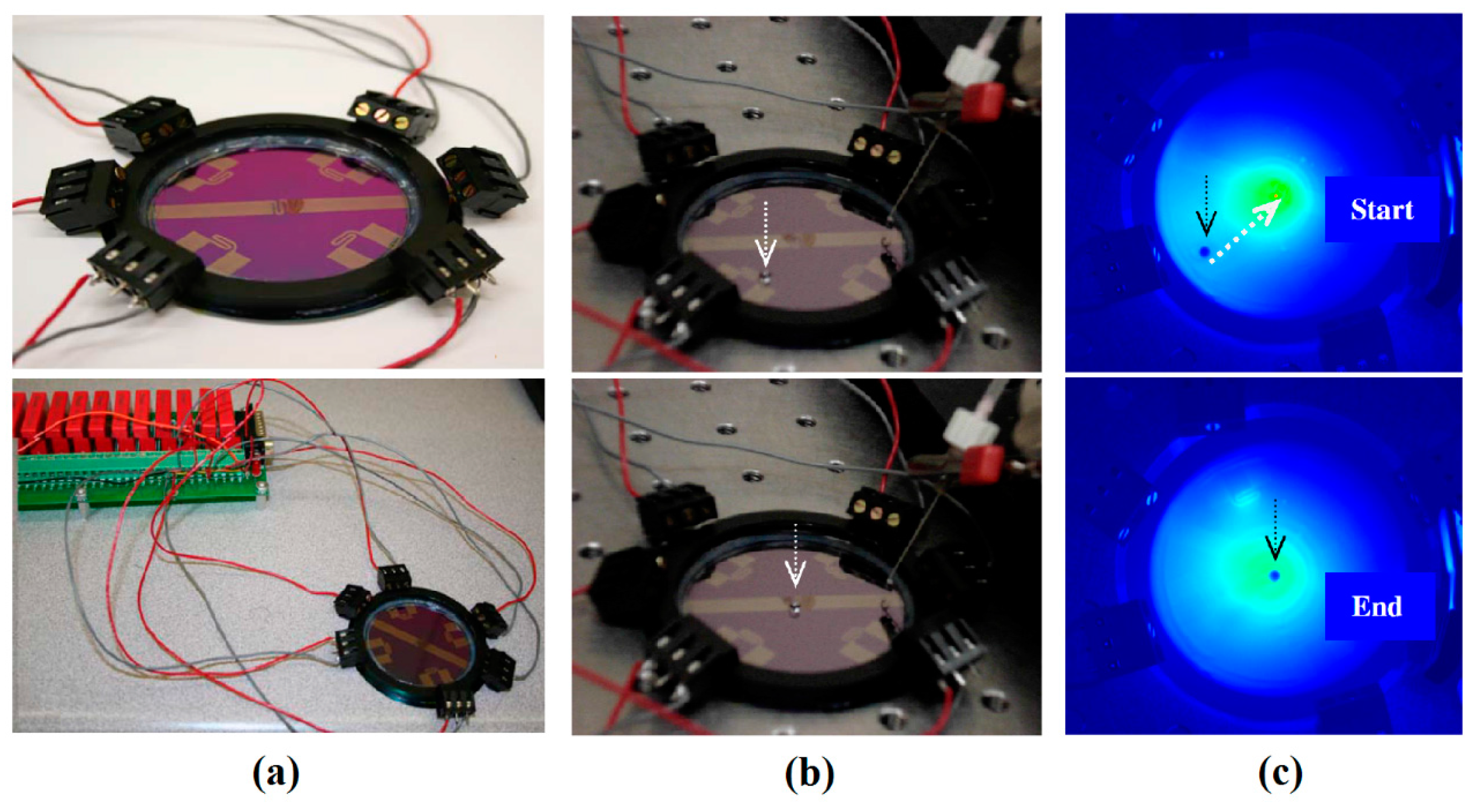
6.2. Thermocapillary Valves, Switches, and Traps
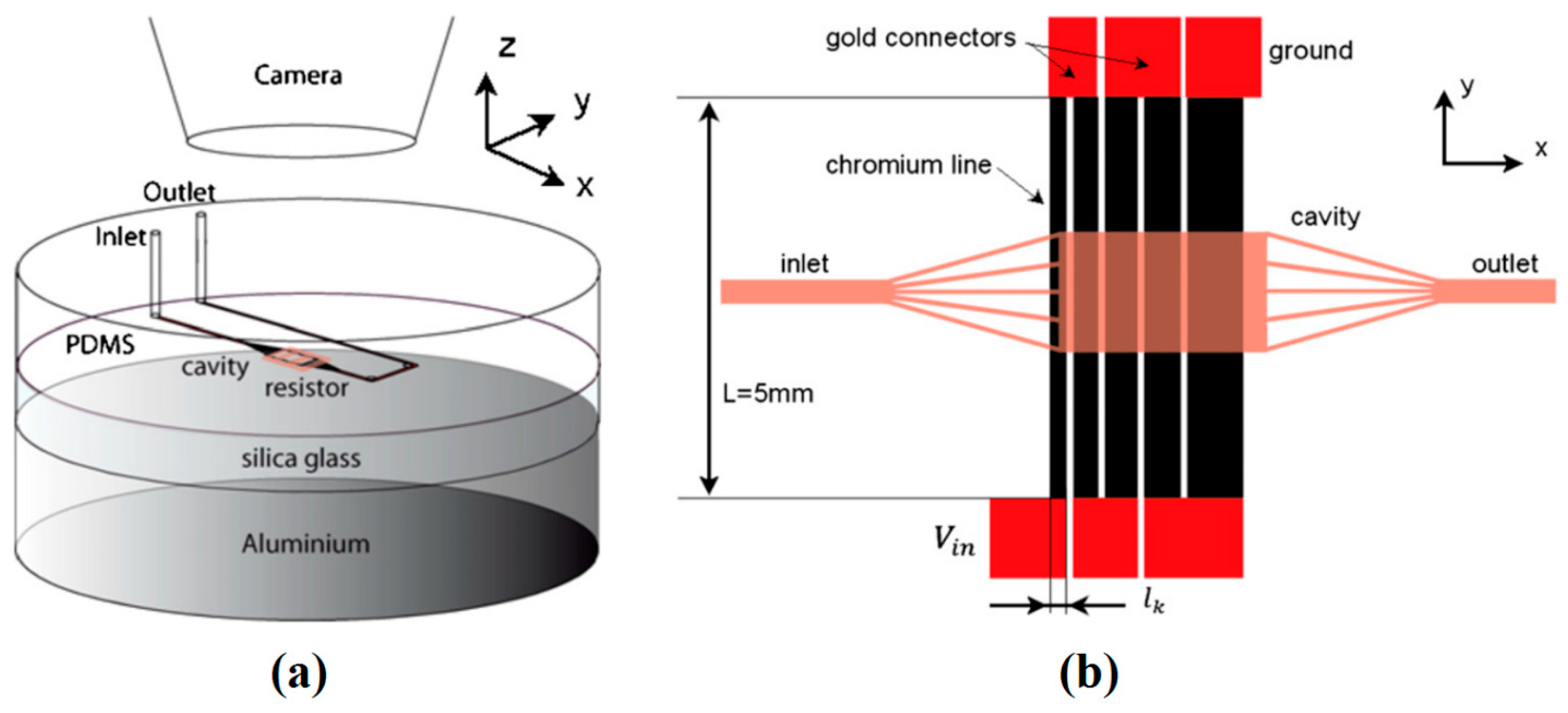
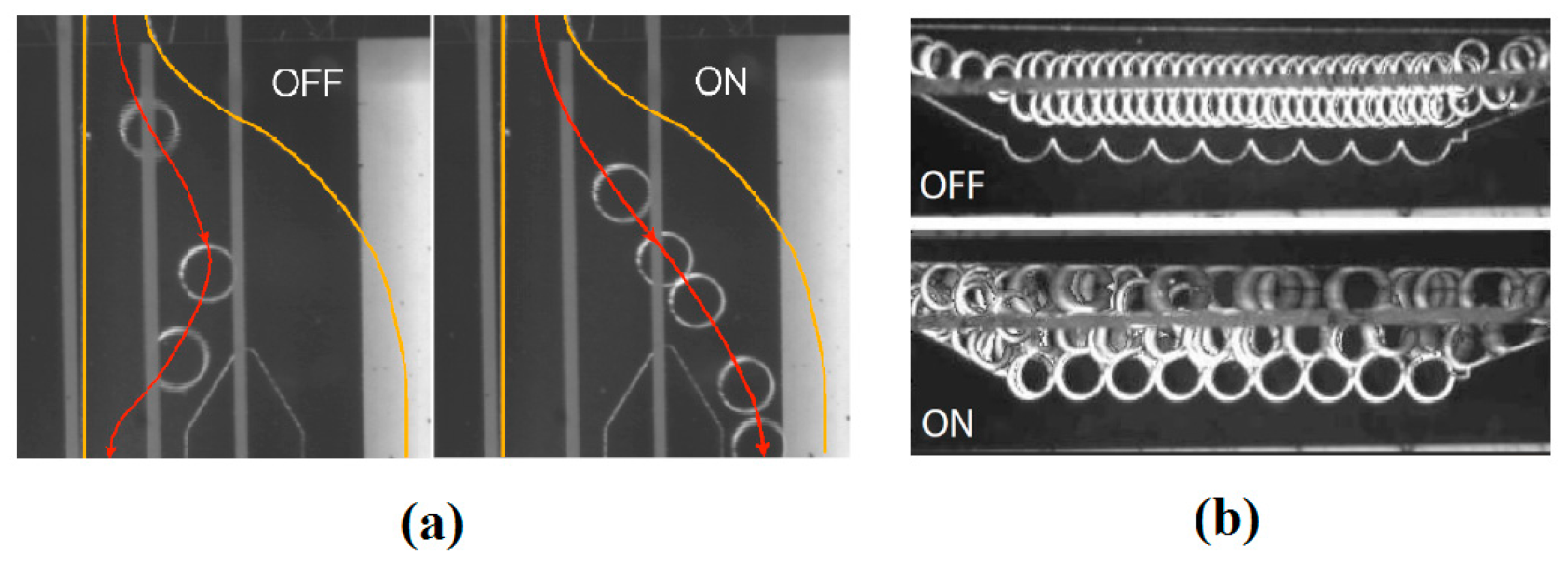
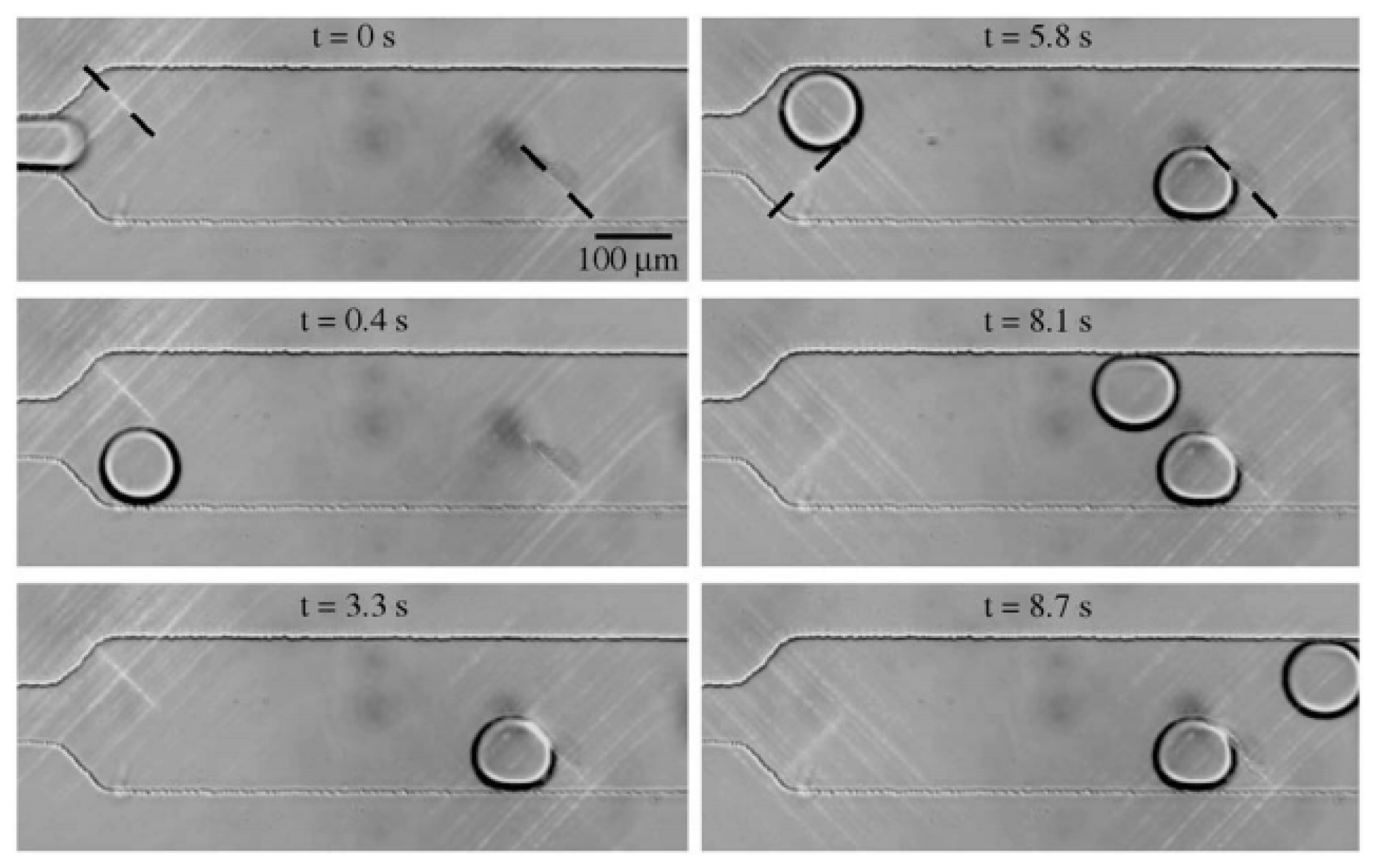
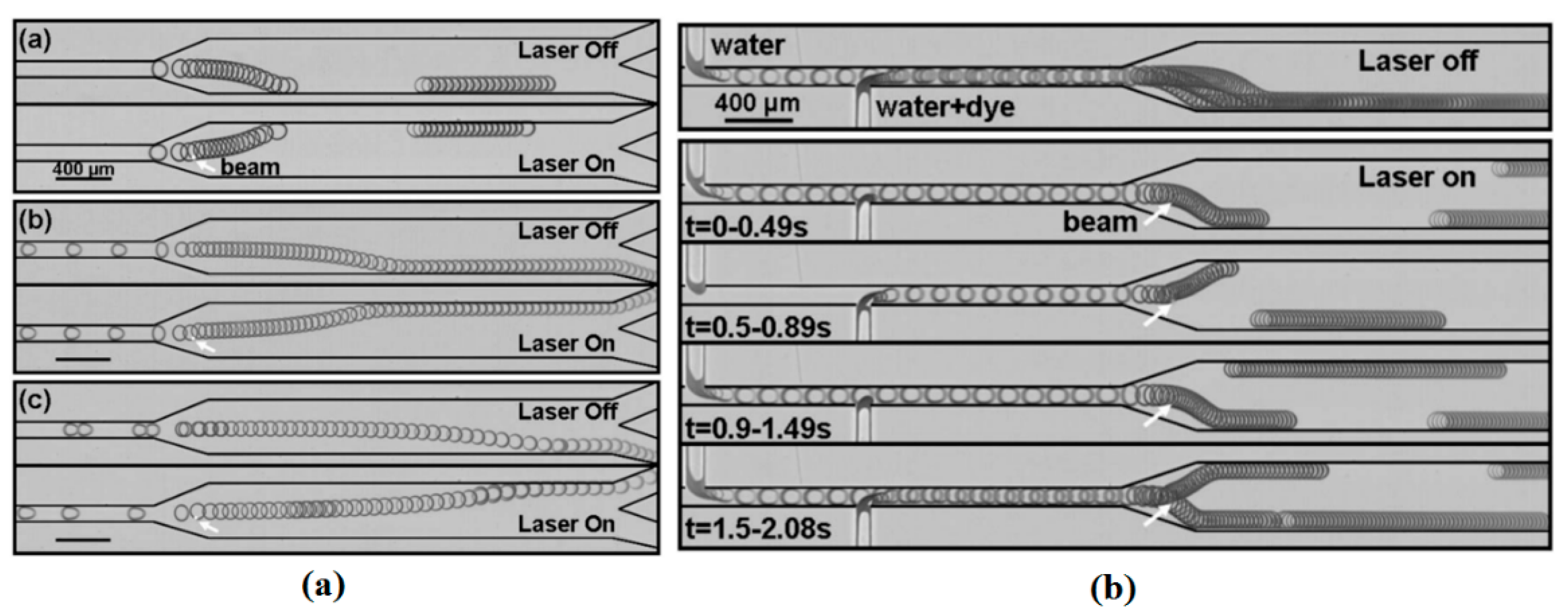
6.3. Thermocapillary Sensors
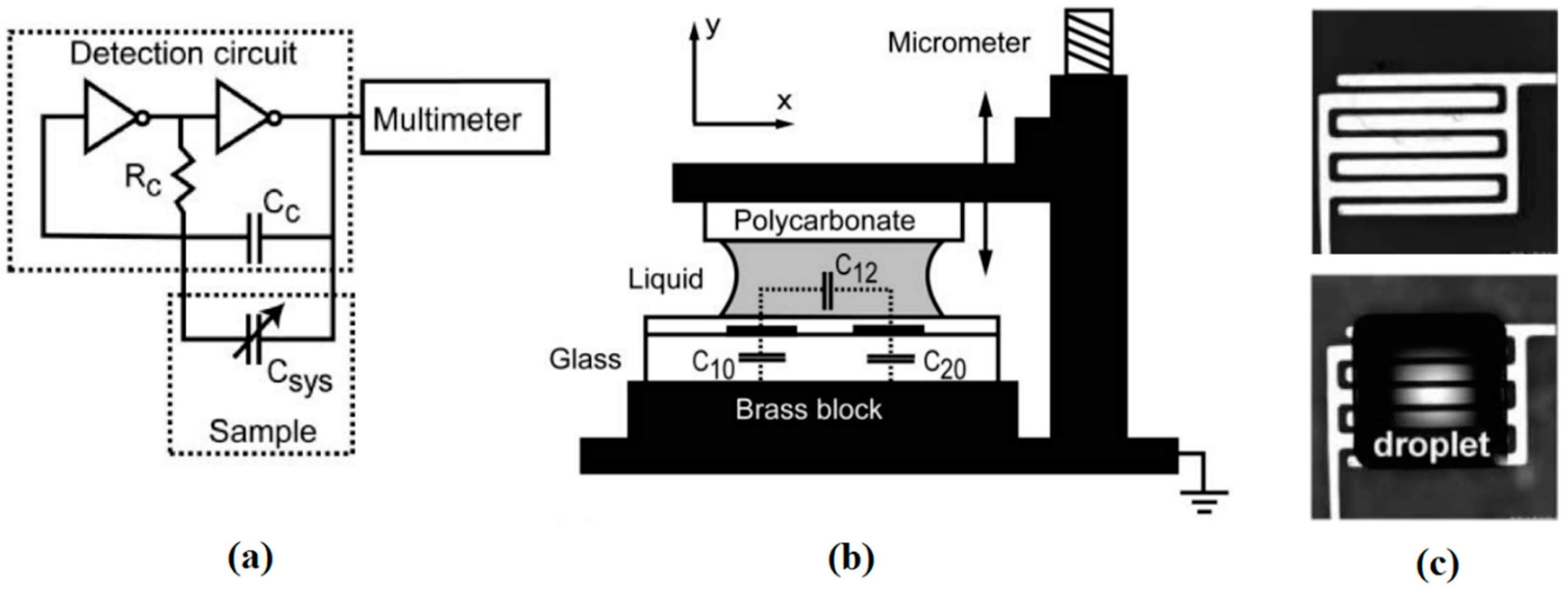

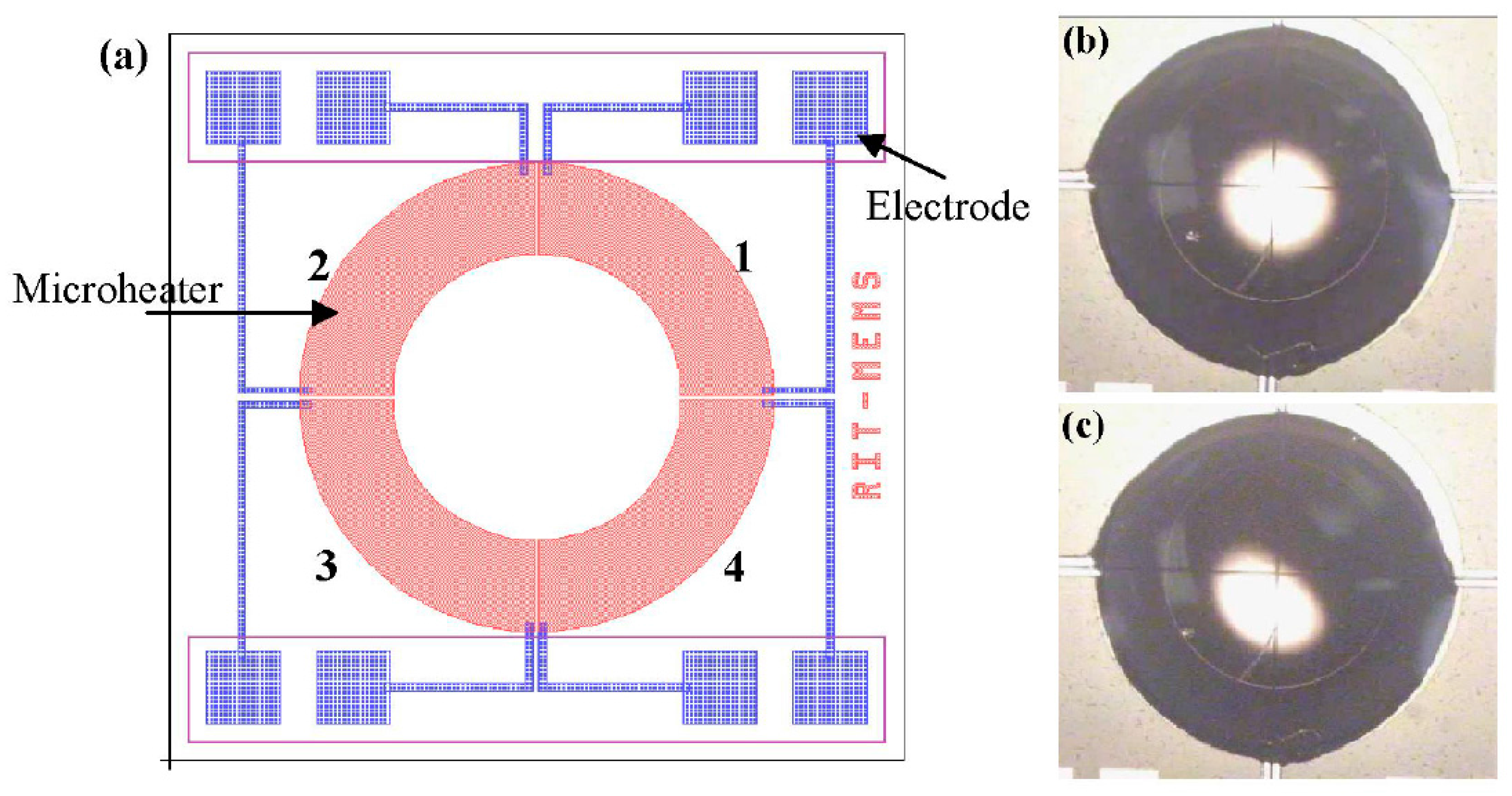
7. Summary
| Configuration | Heat Source | Application | Refs. |
|---|---|---|---|
| Drops and Bubbles in Microchannels | Embedded Al | Droplet Actuation and Mixing | [187] |
| Embedded Poly-Si | Thermocapillary Pumping (TCP) | [188] | |
| Embedded Cr/Ni | Bubble Micro-oscillator | [189] | |
| Embedded Cr | Droplet Switching, Sorting and Trapping | [199,200,201,202] | |
| Laser Beam | Droplet Manipulation | [204] | |
| Laser Beam | Droplet Switching and Sorting | [205] | |
| Drops on Solid Surfaces | Embedded Ti/Au | Droplet Actuator | [190,191] |
| Embedded Ti | Droplet Actuator | [207] | |
| Embedded Ti/Pt | Droplet Mixing/Reaction Measurement | [197,198] | |
| Embedded Poly-Si | Micromirror Actuator | [209] | |
| Embedded Au/Ti | Droplet Manipulation | [196] | |
| Embedded Ti/Au | Nano-Dispenser | [195] | |
| Embedded Ti/Au | Droplet Position, Size, Composition Measurement | [206] | |
| Drops on Liquid Films | Suspended Heaters | Droplet Actuation, Mixing, Trapping, and Pumping | [178] |
| Embedded Ti | Droplet Actuation, Mixing, Trapping, and Sorting | [182] | |
| Miscellaneous | Laser Beam | Microbead Manipulation | [210] |
| Suspended Heaters PCB | Mechanical Power Production | [211] | |
| Cold Metal | Chemical Computation | [212] |
Acknowledgments
Author Contributions
Conflicts of Interest
References
- Squires, T.M.; Quake, S.R. Microfluidics: Fluid physics at the nanoliter scale. Rev. Mod. Phys. 2005, 77, 977. [Google Scholar] [CrossRef]
- Stone, H.A.; Stroock, A.D.; Ajdari, A. Engineering flows in small devices: Microfluidics toward a lab-on-a-chip. Annu. Rev. Fluid Mech. 2004, 36, 381–411. [Google Scholar] [CrossRef]
- Fair, R.B. Digital microfluidics: Is a true lab-on-a-chip possible? Microfluid. Nanofluid. 2007, 3, 245–281. [Google Scholar] [CrossRef]
- Darhuber, A.A.; Troian, S.M. Principles of microfluidic actuation by modulation of surface stresses. Annu. Rev. Fluid Mech. 2005, 37, 425–455. [Google Scholar] [CrossRef]
- Baroud, C.N.; Gallaire, F.; Dangla, R. Dynamics of microfluidic droplets. Lab Chip 2010, 10, 2032–2045. [Google Scholar] [CrossRef] [PubMed]
- Oron, A.; Davis, S.H.; Bankoff, S.G. Long-scale evolution of thin liquid films. Rev. Mod. Phys. 1997, 69, 931. [Google Scholar] [CrossRef]
- Maki, K.L.; Kumar, S. Fast evaporation of spreading droplets of colloidal suspensions. Langmuir 2011, 27, 11347–11363. [Google Scholar] [CrossRef] [PubMed]
- Karapetsas, G.; Sahu, K.C.; Matar, O.K. Effect of contact line dynamics on the thermocapillary motion of a droplet on an inclined plate. Langmuir 2013, 29, 8892–8906. [Google Scholar] [CrossRef] [PubMed]
- Thomson, J. XLII. On certain curious motions observable at the surfaces of wine and other alcoholic liquors. Lond. Edinb. Dublin Philos. Mag. J. Sci. 1855, 10, 330–333. [Google Scholar]
- Marangoni, C. Über die Ausbreitung der Tropfen einer Flüssigkeit auf der Oberfläche einer anderen. Ann. Phys. 1871, 219, 337–354. (In German) [Google Scholar] [CrossRef]
- Bernard, H. Les tourbillons cellulaires dans une nappe liquide (The cellular vortices in a liquid layer). Rev. Gén. Sci. Pure Appl. 1900, 11, 1261–1271. (In French) [Google Scholar]
- Shereshefsky, J. Surface tension of saturated vapors and the equation of Eötvös. J. Phys. Chem. 1931, 35, 1712–1720. [Google Scholar] [CrossRef]
- Villers, D.; Platten, J. Temperature dependence of the interfacial tension between water and long-chain alcohols. J. Phys. Chem. 1988, 92, 4023–4024. [Google Scholar] [CrossRef]
- De Gennes, P.-G. Wetting: Statics and dynamics. Rev. Mod. Phys. 1985, 57, 827. [Google Scholar] [CrossRef]
- Tan, M.; Bankoff, S.; Davis, S. Steady thermocapillary flows of thin liquid layers. I. Theory. Phys. Fluids A Fluid Dyn. 1990, 2, 313–321. [Google Scholar] [CrossRef]
- Rickett, L.M.; Penfold, R.; Blyth, M.G.; Purvis, R.; Cooker, M.J. Incipient mixing by Marangoni effects in slow viscous flow of two immiscible fluid layers. IMA J. Appl. Math. 2015, 80, 1582–1618. [Google Scholar] [CrossRef]
- Cross, M.C.; Hohenberg, P.C. Pattern formation outside of equilibrium. Rev. Mod. Phys. 1993, 65, 851. [Google Scholar] [CrossRef]
- Ostrach, S. Low-gravity fluid flows. Annu. Rev. Fluid Mech. 1982, 14, 313–345. [Google Scholar] [CrossRef]
- Davis, S.H. Thermocapillary instabilities. Annu. Rev. Fluid Mech. 1987, 19, 403–435. [Google Scholar] [CrossRef]
- Pearson, J. On convection cells induced by surface tension. J. Fluid Mech. 1958, 4, 489–500. [Google Scholar] [CrossRef]
- Smith, M.K.; Davis, S.H. Instabilities of dynamic thermocapillary liquid layers. Part 1. Convective instabilities. J. Fluid Mech. 1983, 132, 119–144. [Google Scholar] [CrossRef]
- Cazabat, A.; Heslot, F.; Troian, S.; Carles, P. Fingering instability of thin spreading films driven by temperature gradients. Nature 1990, 346, 824–826. [Google Scholar] [CrossRef]
- Kataoka, D.E.; Troian, S.M. Patterning liquid flow on the microscopic scale. Nature 1999, 402, 794–797. [Google Scholar]
- Joo, S.; Davis, S.; Bankoff, S. Long-wave instabilities of heated falling films: Two-dimensional theory of uniform layers. J. Fluid Mech. 1991, 230, 117–146. [Google Scholar] [CrossRef]
- Bowen, M.; Tilley, B. Thermally induced van der Waals rupture of thin viscous fluid sheets. Phys. Fluids 2012, 24, 032106. [Google Scholar] [CrossRef]
- Burelbach, J.P.; Bankoff, S.G.; Davis, H.S. Nonlinear stability of evaporating/condensing liquid films. J. Fluid Mech. 1988, 195, 463–494. [Google Scholar] [CrossRef]
- Karapetsas, G.; Matar, O.K.; Valluri, P.; Sefiane, K. Convective rolls and hydrothermal waves in evaporating sessile drops. Langmuir 2012, 28, 11433–11439. [Google Scholar] [CrossRef] [PubMed]
- Golovin, A.; Nepomnyashchy, A.; Pismen, L. Pattern formation in large-scale Marangoni convection with deformable interface. Phys. D Nonlinear Phenom. 1995, 81, 117–147. [Google Scholar] [CrossRef]
- Castillo, J.; Velarde, M. Buoyancy-thermocapillary instability: The role of interfacial deformation in one-and two-component fluid layers heated from below or above. J. Fluid Mech. 1982, 125, 463–474. [Google Scholar] [CrossRef]
- Chraïbi, H.; Delville, J.-P. Thermocapillary flows and interface deformations produced by localized laser heating in confined environment. Phys. Fluids 2012, 24, 032102. [Google Scholar] [CrossRef]
- Nahas, N.M.; Panton, R.L. Control of surface tension flows: Instability of a liquid jet. J. Fluids Eng. 1990, 112, 296–301. [Google Scholar] [CrossRef]
- Brenner, M.P.; Paruchuri, S. Thermal bending of liquid sheets and jets. Phys. Fluids 2003, 15, 3568–3571. [Google Scholar] [CrossRef]
- Furlani, E. Temporal instability of viscous liquid microjets with spatially varying surface tension. J. Phys. A Math. Gen. 2005, 38, 263. [Google Scholar] [CrossRef]
- Wanschura, M.; Shevtsova, V.; Kuhlmann, H.; Rath, H. Convective instability mechanisms in thermocapillary liquid bridges. Phys. Fluids 1995, 7, 912–925. [Google Scholar] [CrossRef]
- Preisser, F.; Schwabe, D.; Scharmann, A. Steady and oscillatory thermocapillary convection in liquid columns with free cylindrical surface. J. Fluid Mech. 1983, 126, 545–567. [Google Scholar] [CrossRef]
- Schwabe, D.; Möller, U.; Schneider, J.; Scharmann, A. Instabilities of shallow dynamic thermocapillary liquid layers. Phys. Fluids A Fluid Dyn. 1992, 4, 2368–2381. [Google Scholar] [CrossRef]
- Velten, R.; Schwabe, D.; Scharmann, A. The periodic instability of thermocapillary convection in cylindrical liquid bridges. Phys. Fluids A Fluid Dyn. 1991, 3, 267–279. [Google Scholar] [CrossRef]
- Riley, R.; Neitzel, G. Instability of thermocapillary-buoyancy convection in shallow layers. Part 1. Characterization of steady and oscillatory instabilities. J. Fluid Mech. 1998, 359, 143–164. [Google Scholar] [CrossRef]
- Benz, S.; Hintz, P.; Riley, R.; Neitzel, G. Instability of thermocapillary–buoyancy convection in shallow layers. Part 2. Suppression of hydrothermal waves. J. Fluid Mech. 1998, 359, 165–180. [Google Scholar] [CrossRef]
- Schatz, M.F.; Neitzel, G.P. Experiments on thermocapillary instabilities. Annu. Rev. Fluid Mech. 2001, 33, 93–127. [Google Scholar] [CrossRef]
- Schatz, M.F.; van Hook, S.J.; McCormick, W.; Swift, J.; Swinney, H.L. Time-independent square patterns in surface-tension-driven Bénard convection. Phys. Fluids 1999, 11, 2577–2582. [Google Scholar] [CrossRef]
- Schatz, M.F.; VanHook, S.J.; McCormick, W.D.; Swift, J.; Swinney, H.L. Onset of surface-tension-driven Bénard convection. Phys. Rev. Lett. 1995, 75, 1938–1941. [Google Scholar] [CrossRef] [PubMed]
- Semwogerere, D.; Schatz, M.F. Evolution of hexagonal patterns from controlled initial conditions in a Bénard-Marangoni convection experiment. Phys. Rev. Lett. 2002, 88, 054501. [Google Scholar] [CrossRef] [PubMed]
- VanHook, S.J.; Schatz, M.F.; McCormick, W.D.; Swift, J.; Swinney, H.L. Long-wavelength instability in surface-tension-driven Bénard convection. Phys. Rev. Lett. 1995, 75, 4397. [Google Scholar] [CrossRef] [PubMed]
- Vanhook, S.J.; Schatz, M.F.; Swift, J.; McCormick, W.; Swinney, H.L. Long-wavelength surface-tension-driven Bénard convection: Experiment and theory. J. Fluid Mech. 1997, 345, 45–78. [Google Scholar] [CrossRef]
- Garnier, N.; Grigoriev, R.O.; Schatz, M.F. Optical manipulation of microscale fluid flow. Phys. Rev. Lett. 2003, 91, 054501. [Google Scholar] [CrossRef] [PubMed]
- Deissler, R.J.; Oron, A. Stable localized patterns in thin liquid films. Phys. Rev. Lett. 1992, 68, 2948. [Google Scholar] [CrossRef] [PubMed]
- Oron, A. Nonlinear dynamics of three-dimensional long-wave Marangoni instability in thin liquid films. Phys. Fluids 2000, 12, 1633–1645. [Google Scholar] [CrossRef]
- Oron, A.; Nepomnyashchy, A. Long-wavelength thermocapillary instability with the Soret effect. Phys. Rev. E 2004, 69, 016313. [Google Scholar] [CrossRef] [PubMed]
- Oron, A.; Rosenau, P. Formation of patterns induced by thermocapillarity and gravity. J. Phys. II 1992, 2, 131–146. [Google Scholar] [CrossRef] [Green Version]
- Oron, A.; Rosenau, P. On a nonlinear thermocapillary effect in thin liquid layers. J. Fluid Mech. 1994, 273, 361–374. [Google Scholar] [CrossRef]
- Scheid, B.; Oron, A.; Colinet, P.; Thiele, U.; Legros, J.C. Nonlinear evolution of nonuniformly heated falling liquid films. Phys. Fluids 2002, 14, 4130–4151. [Google Scholar] [CrossRef]
- Sáenz, P.J.; Valluri, P.; Sefiane, K.; Matar, O.K. Stability and Two-phase Dynamics of Evaporating Marangoni-driven Flows in Laterally-heated Liquid Layers and Sessile Droplets. Procedia IUTAM 2015, 15, 116–123. [Google Scholar] [CrossRef] [Green Version]
- Sultan, E.; Boudaoud, A.; Amar, M.B. Evaporation of a thin film: Diffusion of the vapour and Marangoni instabilities. J. Fluid Mech. 2005, 543, 183–202. [Google Scholar] [CrossRef]
- Kavehpour, P.; Ovryn, B.; McKinley, G.H. Evaporatively-driven Marangoni instabilities of volatile liquid films spreading on thermally conductive substrates. Colloids Surf. A Physicochem. Eng. Asp. 2002, 206, 409–423. [Google Scholar] [CrossRef]
- Buffone, C.; Sefiane, K.; Easson, W. Marangoni-driven instabilities of an evaporating liquid-vapor interface. Phys. Rev. E 2005, 71, 056302. [Google Scholar] [CrossRef] [PubMed]
- Deegan, R.D.; Bakajin, O.; Dupont, T.F.; Huber, G.; Nagel, S.R.; Witten, T.A. Contact line deposits in an evaporating drop. Phys. Rev. E 2000, 62, 756. [Google Scholar] [CrossRef]
- Fischer, B.J. Particle convection in an evaporating colloidal droplet. Langmuir 2002, 18, 60–67. [Google Scholar] [CrossRef]
- Hu, H.; Larson, R.G. Evaporation of a sessile droplet on a substrate. J. Phys. Chem. B 2002, 106, 1334–1344. [Google Scholar] [CrossRef]
- Hu, H.; Larson, R.G. Analysis of the microfluid flow in an evaporating sessile droplet. Langmuir 2005, 21, 3963–3971. [Google Scholar] [CrossRef] [PubMed]
- Hu, H.; Larson, R.G. Analysis of the effects of Marangoni stresses on the microflow in an evaporating sessile droplet. Langmuir 2005, 21, 3972–3980. [Google Scholar] [CrossRef] [PubMed]
- Bhardwaj, R.; Fang, X.; Attinger, D. Pattern formation during the evaporation of a colloidal nanoliter drop: A numerical and experimental study. New J. Phys. 2009, 11, 075020. [Google Scholar] [CrossRef]
- Barash, L.Y. Dependence of fluid flows in an evaporating sessile droplet on the characteristics of the substrate. Int. J. Heat Mass Transf. 2015, 84, 419–426. [Google Scholar] [CrossRef]
- Shih, A.T.; Megaridis, C.M. Thermocapillary flow effects on convective droplet evaporation. Int. J. Heat Mass Transf. 1996, 39, 247–257. [Google Scholar] [CrossRef]
- Marek, R.; Straub, J. Analysis of the evaporation coefficient and the condensation coefficient of water. Int. J. Heat Mass Transf. 2001, 44, 39–53. [Google Scholar] [CrossRef]
- Ajaev, V.S. Spreading of thin volatile liquid droplets on uniformly heated surfaces. J. Fluid Mech. 2005, 528, 279–296. [Google Scholar] [CrossRef]
- Sodtke, C.; Ajaev, V.S.; Stephan, P. Dynamics of volatile liquid droplets on heated surfaces: Theory versus experiment. J. Fluid Mech. 2008, 610, 343–362. [Google Scholar] [CrossRef]
- Chao, D.F.; Zhang, N. Effects of evaporation and thermocapillary convection on volatile liquid droplets. Int. J. Heat Mass Transf. 2001, 15, 416–420. [Google Scholar] [CrossRef]
- Truskett, V.N.; Stebe, K.J. Influence of surfactants on an evaporating drop: Fluorescence images and particle deposition patterns. Langmuir 2003, 19, 8271–8279. [Google Scholar] [CrossRef]
- Gonuguntla, M.; Sharma, A. Polymer patterns in evaporating droplets on dissolving substrates. Langmuir 2004, 20, 3456–3463. [Google Scholar] [CrossRef] [PubMed]
- Buffone, C.; Sefiane, K. Investigation of thermocapillary convective patterns and their role in the enhancement of evaporation from pores. Int. J. Multiph. Flow 2004, 30, 1071–1091. [Google Scholar] [CrossRef]
- Chai, A.-T.; Zhang, N. Experimental study of Marangoni-Bénard convection in a liquid layer induced by evaporation. Exp. Heat Transfer J. Therm. Energy Gener. Transp. Storage Convers. 1998, 11, 187–205. [Google Scholar] [CrossRef]
- Potash, M.; Wayner, P. Evaporation from a two-dimensional extended meniscus. Int. J. Heat Mass Transf. 1972, 15, 1851–1863. [Google Scholar] [CrossRef]
- Ruiz, O.E.; Black, W.Z. Evaporation of water droplets placed on a heated horizontal surface. J. Heat Transf. 2002, 124, 854–863. [Google Scholar] [CrossRef]
- Girard, F.; Antoni, M.; Faure, S.; Steinchen, A. Evaporation and Marangoni driven convection in small heated water droplets. Langmuir 2006, 22, 11085–11091. [Google Scholar] [CrossRef] [PubMed]
- Girard, F.; Antoni, M.; Sefiane, K. On the effect of Marangoni flow on evaporation rates of heated water drops. Langmuir 2008, 24, 9207–9210. [Google Scholar] [CrossRef] [PubMed]
- Dunn, G.; Wilson, S.; Duffy, B.; David, S.; Sefiane, K. The strong influence of substrate conductivity on droplet evaporation. J. Fluid Mech. 2009, 623, 329–351. [Google Scholar] [CrossRef]
- Barash, L.Y.; Bigioni, T.; Vinokur, V.; Shchur, L. Evaporation and fluid dynamics of a sessile drop of capillary size. Phys. Rev. E 2009, 79, 046301. [Google Scholar] [CrossRef] [PubMed]
- Ranjan, R.; Murthy, J.Y.; Garimella, S.V. A microscale model for thin-film evaporation in capillary wick structures. Int. J. Heat Mass Transf. 2011, 54, 169–179. [Google Scholar] [CrossRef]
- Erbil, H.Y. Evaporation of pure liquid sessile and spherical suspended drops: A review. Adv. Colloid Interface Sci. 2012, 170, 67–86. [Google Scholar] [CrossRef] [PubMed]
- Zhong, X.; Crivoi, A.; Duan, F. Sessile nanofluid droplet drying. Adv. Colloid Int. Sci. 2015, 217, 13–30. [Google Scholar] [CrossRef] [PubMed]
- Kovalchuk, N.; Trybala, A.; Starov, V. Evaporation of sessile droplets. Curr. Opin. Colloid Interface Sci. 2014, 19, 336–342. [Google Scholar] [CrossRef]
- Benintendi, S.W.; Smith, M.K. The spreading of a non-isothermal liquid droplet. Phys. Fluids 1999, 11, 982–989. [Google Scholar] [CrossRef] [Green Version]
- Ehrhard, P.; Davis, S.H. Non-isothermal spreading of liquid drops on horizontal plates. J. Fluid Mech. 1991, 229, 365–388. [Google Scholar] [CrossRef]
- Haley, P.J.; Miksis, M.J. The effect of the contact line on droplet spreading. J. Fluid Mech. 1991, 223, 57–81. [Google Scholar] [CrossRef]
- Nguyen, H.-B.; Chen, J.-C. Numerical study of a droplet migration induced by combined thermocapillary-buoyancy convection. Phys. Fluids 2010, 22, 122101. [Google Scholar] [CrossRef]
- Karapetsas, G.; Sahu, K.C.; Sefiane, K.; Matar, O.K. Thermocapillary-driven motion of a sessile drop: Effect of non-monotonic dependence of surface tension on temperature. Langmuir 2014, 30, 4310–4321. [Google Scholar] [CrossRef] [PubMed]
- Liu, H.; Zhang, Y. Modelling thermocapillary migration of a microfluidic droplet on a solid surface. J. Comput. Phys. 2015, 280, 37–53. [Google Scholar] [CrossRef]
- Brzoska, J.; Brochard-Wyart, F.; Rondelez, F. Motions of droplets on hydrophobic model surfaces induced by thermal gradients. Langmuir 1993, 9, 2220–2224. [Google Scholar] [CrossRef]
- Chen, J.Z.; Troian, S.M.; Darhuber, A.A.; Wagner, S. Effect of contact angle hysteresis on thermocapillary droplet actuation. J. Appl. Phys. 2005, 97, 014906. [Google Scholar] [CrossRef]
- Ford, M.L.; Nadim, A. Thermocapillary migration of an attached drop on a solid surface. Phys. Fluids 1994, 6, 3183–3185. [Google Scholar] [CrossRef]
- Pratap, V.; Moumen, N.; Subramanian, R.S. Thermocapillary motion of a liquid drop on a horizontal solid surface. Langmuir 2008, 24, 5185–5193. [Google Scholar] [CrossRef] [PubMed]
- Baier, T.; Steffes, C.; Hardt, S. Thermocapillary flow on superhydrophobic surfaces. Phys. Rev. E 2010, 82, 037301. [Google Scholar] [CrossRef] [PubMed]
- Zhao, Y.; Liu, F.; Chen, C.-H. Thermocapillary actuation of binary drops on solid surfaces. Appl. Phys. Lett. 2011, 99, 104101. [Google Scholar] [CrossRef]
- Pimputkar, S.M.; Ostrach, S. Transient thermocapillary flow in thin liquid layers. Phys. Fluids 1980, 23, 1281–1285. [Google Scholar] [CrossRef]
- Sen, A.K.; Davis, S.H. Steady thermocapillary flows in two-dimensional slots. J. Fluid Mech. 1982, 121, 163–186. [Google Scholar] [CrossRef]
- Bratukhin, Y.K. Thermocapillary drift of a droplet of viscous liquid. Fluid Dyn. 1975, 10, 833–837. [Google Scholar] [CrossRef]
- Bratukhin, Y.K.; Zuev, A. Thermocapillary drift of an air bubble in a horizontal Hele-Shaw cell. Fluid Dyn. 1984, 19, 393–398. [Google Scholar] [CrossRef]
- Greco, E.F.; Grigoriev, R.O. Thermocapillary migration of interfacial droplets. Phys. Fluids 2009, 21, 042105. [Google Scholar] [CrossRef]
- Balasubramaniam, R.; Chai, A.-T. Thermocapillary migration of droplets: An exact solution for small Marangoni numbers. J. Colloid Interface Sci. 1987, 119, 531–538. [Google Scholar] [CrossRef]
- Zhou, L.; Wei, L.; Li, Y.; Du, X.; Wang, B. Bubble circling phenomena in subcooled nucleate pool boiling on microwires. Int. J. Heat Mass Transf. 2013, 64, 945–951. [Google Scholar] [CrossRef]
- Zhou, L.; Du, X.; Yang, Y.; Jiang, P.; Wang, B. Thermocapillary effect on bubble sweeping and circling during subcooled nucleate pool boiling of water over microwire. Int. J. Heat Mass Transf. 2015, 88, 276–283. [Google Scholar] [CrossRef]
- Haj-Hariri, H.; Shi, Q.; Borhan, A. Thermocapillary motion of deformable drops at finite Reynolds and Marangoni numbers. Phys. Fluids 1997, 9, 845–855. [Google Scholar] [CrossRef]
- Ajaev, V.S.; Homsy, G. Steady vapor bubbles in rectangular microchannels. J. Colloid Interface Sci. 2001, 240, 259–271. [Google Scholar] [CrossRef] [PubMed]
- Mazouchi, A.; Homsy, G. Thermocapillary migration of long bubbles in polygonal tubes. I. Theory. Phys. Fluids 2001, 13, 1594–1600. [Google Scholar] [CrossRef]
- Lajeunesse, E.; Homsy, G. Thermocapillary migration of long bubbles in polygonal tubes. II. Experiments. Phys. Fluids 2003, 15, 308–314. [Google Scholar] [CrossRef]
- Wang, Y.; Lu, X.; Zhuang, L.; Tang, Z.; Hu, W. Numerical simulation of drop Marangoni migration under microgravity. Acta Astronaut. 2004, 54, 325–335. [Google Scholar] [CrossRef]
- Yin, Z.-H.; Gao, P.; Hu, W.-R.; Chang, L. Thermocapillary migration of nondeformable drops. Phys. Fluids 2008, 20, 082101. [Google Scholar] [CrossRef]
- Gao, P.; Yin, Z.; Hu, W. Thermocapillary motion of droplets at large Marangoni numbers. Adv. Space Res. 2008, 41, 2101–2106. [Google Scholar] [CrossRef] [Green Version]
- Glockner, P.; Naterer, G. Thermocapillary control of microfluidic transport with a stationary cyclic heat source. J. Micromech. Microeng. 2005, 15, 2216. [Google Scholar] [CrossRef]
- Chang, L.; Yin, Z.; Hu, W. Transient behavior of the thermocapillary migration of drops under the influence of deformation. ArXiv E-Prints 2011. [Google Scholar] [CrossRef] [Green Version]
- Choudhuri, D.; Sekhar, G.R. Thermocapillary drift on a spherical drop in a viscous fluid. Phys. Fluids 2013, 25, 043104. [Google Scholar] [CrossRef]
- Glockner, P.; Naterer, G. Surface tension and frictional resistance of thermocapillary pumping in a closed microchannel. Int. J. Heat Mass Transf. 2006, 49, 4424–4436. [Google Scholar] [CrossRef]
- Yang, Y.; Odukoya, A.; Naterer, G. Droplet meniscus motion of thermocapillary pumping in a closed microchannel with external heating. In Proceedings of the 12th IEEE Intersociety Conference on Thermal and Thermomechanical Phenomena in Electronic Systems (ITherm), Las Vegas, NV, USA, 2–5 June 2010; pp. 1–6.
- Lai, F.C. Numerical Simulation of Thermocapillary Pumping Using the Volume of Fluid Method. Proc. Okla. Acad. Sci. 2015, 86, 75–83. [Google Scholar]
- Liu, H.; Zhang, Y.; Valocchi, A.J. Modeling and simulation of thermocapillary flows using lattice Boltzmann method. J. Comput. Phys. 2012, 231, 4433–4453. [Google Scholar] [CrossRef]
- Liu, H.; Valocchi, A.J.; Zhang, Y.; Kang, Q. Lattice Boltzmann phase-field modeling of thermocapillary flows in a confined microchannel. J. Comput. Phys. 2014, 256, 334–356. [Google Scholar] [CrossRef]
- Baird, E.; Mohseni, K. A unified velocity model for digital microfluidics. Nanoscale Microscale Thermophys. Eng. 2007, 11, 109–120. [Google Scholar] [CrossRef]
- Hadland, P.; Balasubramaniam, R.; Wozniak, G.; Subramanian, R. Thermocapillary migration of bubbles and drops at moderate to large Marangoni number and moderate Reynolds number in reduced gravity. Exp. Fluids 1999, 26, 240–248. [Google Scholar] [CrossRef]
- Treuner, M.; Galindo, V.; Gerbeth, G.; Langbein, D.; Rath, H.J. Thermocapillary bubble migration at high Reynolds and Marangoni numbers under low gravity. J. Colloid Interface Sci. 1996, 179, 114–127. [Google Scholar] [CrossRef]
- Xie, J.-C.; Lin, H.; Zhang, P.; Liu, F.; Hu, W.-R. Experimental investigation on thermocapillary drop migration at large Marangoni number in reduced gravity. J. Colloid Interface Sci. 2005, 285, 737–743. [Google Scholar] [CrossRef] [PubMed][Green Version]
- Young, N.; Goldstein, J.; Block, M. The motion of bubbles in a vertical temperature gradient. J. Fluid Mech. 1959, 6, 350–356. [Google Scholar] [CrossRef]
- Zhang, L.; Subramanian, R.S.; Balasubramaniam, R. Motion of a drop in a vertical temperature gradient at small Marangoni number—The critical role of inertia. J. Fluid Mech. 2001, 448, 197–211. [Google Scholar] [CrossRef]
- Harper, J.; Moore, D.; Pearson, J. The effect of the variation of surface tension with temperature on the motion of bubbles and drops. J. Fluid Mech. 1967, 27, 361–366. [Google Scholar] [CrossRef]
- Bratukhin, Y.K.; Kostarev, K.; Viviani, A.; Zuev, A. Experimental study of Marangoni bubble migration in normal gravity. Exp. Fluids 2005, 38, 594–605. [Google Scholar] [CrossRef]
- Jiao, Z.; Nguyen, N.-T.; Huang, X. Thermocapillary actuation of liquid plugs using a heater array. Sens. Actuators A Phys. 2007, 140, 145–155. [Google Scholar] [CrossRef]
- Jiao, Z.; Nguyen, N.-T.; Huang, X.; Ang, Y.Z. Reciprocating thermocapillary plug motion in an externally heated capillary. Microfluid. Nanofluid. 2007, 3, 39–46. [Google Scholar] [CrossRef]
- Nguyen, N.-T.; Huang, X. Thermocapillary effect of a liquid plug in transient temperature fields. Jpn. J. Appl. Phys. 2005, 44, 1139–1142. [Google Scholar] [CrossRef]
- Nguyen, N.-T.; Jiao, Z.; Huang, X. Theoretical and experimental investigation of thermocapillary actuation for microplugs. Proc. SPIE 2006, 6415, 64150D. [Google Scholar]
- Nguyen, N.-T.; Pang, W.W.; Huang, X. Sample transport with thermocapillary force for microfluidics. J. Phys. Conf. Ser. 2006, 34, 967. [Google Scholar] [CrossRef]
- Jiao, Z.; Nguyen, N.-T.; Huang, X. Chaotic motion of microplugs under high-frequency thermocapillary actuation. J. Micromech. Microeng. 2007, 17, 180. [Google Scholar] [CrossRef]
- Jiao, Z.; Nguyen, N.-T.; Huang, X. Thermocapillary actuation of a water droplet encapsulated in an oil plug. J. Micromech. Microeng. 2007, 17, 1843–1852. [Google Scholar] [CrossRef]
- Jiao, Z. Thermocapillary actuation and droplet manipulation in microfluidics. Ph.D. Thesis, Nanyang Technological University, Singapore, 2009. [Google Scholar]
- Jiao, Z.; Nguyen, N.-T. Thermocapillary Pumping. In Encyclopedia of Microfluidics and Nanofluidics; Springer: Berlin, Germany, 2008; pp. 2037–2040. [Google Scholar]
- Namura, K.; Nakajima, K.; Kimura, K.; Suzuki, M. Photothermally controlled Marangoni flow around a micro bubble. Appl. Phys. Lett. 2015, 106, 043101. [Google Scholar] [CrossRef]
- Baroud, C.N.; Delville, J.-P.; Gallaire, F.; Wunenburger, R. Thermocapillary valve for droplet production and sorting. Phys. Rev. E 2007, 75, 046302. [Google Scholar] [CrossRef] [PubMed]
- Gallaire, F.; Baroud, C.; Delville, J.-P. Thermocapillary manipulation of microfluidic droplets: Theory and applications. Int. J. Heat Technol. 2008, 26, 161–166. [Google Scholar]
- Glockner, P.; Naterer, G. Interfacial thermocapillary pressure of an accelerated droplet in microchannels: Part I. Fluid flow formulation. Int. J. Heat Mass Transf. 2007, 50, 5269–5282. [Google Scholar] [CrossRef]
- Glockner, P.; Naterer, G. Interfacial thermocapillary pressure of an accelerated droplet in microchannels: Part II. Heat transfer formulation. Int. J. Heat Mass Transf. 2007, 50, 5283–5291. [Google Scholar] [CrossRef]
- Baroud, C.N.; de Saint-Vincent, M.R.; Delville, J.-P. An optical toolbox for total control of droplet microfluidics. Lab Chip 2007, 7, 1029–1033. [Google Scholar] [CrossRef] [PubMed]
- Verneuil, E.; Cordero, M.A.; Gallaire, F.; Baroud, C.N. Laser-induced force on a microfluidic drop: Origin and magnitude. Langmuir 2009, 25, 5127–5134. [Google Scholar] [CrossRef] [PubMed]
- Ohta, A.T.; Jamshidi, A.; Valley, J.K.; Hsu, H.-Y.; Wu, M.C. Optically actuated thermocapillary movement of gas bubbles on an absorbing substrate. Appl. Phys. Lett. 2007, 91, 074103. [Google Scholar] [CrossRef] [PubMed]
- Kotz, K.; Noble, K.; Faris, G. Optical microfluidics. Appl. Phys. Lett. 2004, 85, 2658–2660. [Google Scholar] [CrossRef]
- Kotz, K.T.; Gu, Y.; Faris, G.W. Optically addressed droplet-based protein assay. J. Am. Chem. Soc. 2005, 127, 5736–5737. [Google Scholar] [CrossRef] [PubMed]
- Dixit, S.S.; Kim, H.; Vasilyev, A.; Eid, A.; Faris, G.W. Light-driven formation and rupture of droplet bilayers. Langmuir 2010, 26, 6193–6200. [Google Scholar] [CrossRef] [PubMed]
- Horowitz, V.R.; Awschalom, D.D.; Pennathur, S. Optofluidics: Field or technique? Lab Chip 2008, 8, 1856–1863. [Google Scholar] [PubMed]
- Delville, J.-P.; de Saint-Vincent, M.R.; RSchroll, D.; Chraibi, H.; Issenmann, B.; Wunenburger, R.; Lasseux, D.; Zhang, W.W.; Brasselet, E. Laser microfluidics: Fluid actuation by light. J. Opt. A Pure Appl. Opt. 2009, 11, 034015. [Google Scholar] [CrossRef]
- Park, S.-Y.; Chiou, P.-Y. Light-driven droplet manipulation technologies for lab-on-a-chip applications. Adv. OptoElectron. 2011, 2011, 909174. [Google Scholar] [CrossRef]
- Baigl, D. Photo-actuation of liquids for light-driven microfluidics: State of the art and perspectives. Lab Chip 2012, 12, 3637–3653. [Google Scholar] [CrossRef] [PubMed]
- Grigoriev, R.O. Chaotic mixing in thermocapillary-driven microdroplets. Phys. Fluids 2005, 17, 033601. [Google Scholar] [CrossRef]
- Grigoriev, R.O.; Schatz, M.F.; Sharma, V. Chaotic mixing in microdroplets. Lab Chip 2006, 6, 1369–1372. [Google Scholar] [CrossRef] [PubMed]
- Vainchtein, D.L.; Widloski, J.; Grigoriev, R.O. Mixing properties of steady flow in thermocapillary driven droplets. Phys. Fluids 2007, 19, 067102. [Google Scholar] [CrossRef]
- Darhuber, A.; Chen, J.; Davis, J.; Troian, S. A study of mixing in thermocapillary flows on micropatterned surfaces. Philos. Trans. R. Soc. Lond. A Math. Phys. Eng. Sci. 2004, 362, 1037–1058. [Google Scholar] [CrossRef] [PubMed]
- Muruganathan, R.; Zhang, Y.; Fischer, T.M. Interfacial thermocapillary vortical flow for microfluidic mixing. J. Am. Chem. Soc. 2006, 128, 3474–3475. [Google Scholar] [CrossRef] [PubMed]
- Cordero, M.L.; Rolfsnes, H.O.; Burnham, D.R.; Campbell, P.A.; McGloin, D.; Baroud, C.N. Mixing via thermocapillary generation of flow patterns inside a microfluidic drop. New J. Phys. 2009, 11, 075033. [Google Scholar] [CrossRef]
- Monti, R.; Savino, R.; Tempesta, S. Wetting prevention by thermal Marangoni effect. Experimental and numerical simulation. Eur. J. Mech. B Fluids 1998, 17, 51–77. [Google Scholar] [CrossRef]
- Khan, M.S.; Kannangara, D.; Shen, W.; Garnier, G. Isothermal noncoalescence of liquid droplets at the air-liquid interface. Langmuir 2008, 24, 3199–3204. [Google Scholar] [CrossRef] [PubMed]
- Chen, J.-C.; Kuo, C.-W.; Neitzel, G. Numerical simulation of thermocapillary nonwetting. Int. J. Heat Mass Transf. 2006, 49, 4567–4576. [Google Scholar] [CrossRef]
- Choi, S.B.; Lee, J.S. Film drainage mechanism between two immiscible droplets. Microfluid. Nanofluid. 2014, 17, 675–681. [Google Scholar] [CrossRef]
- Savino, R.; Monti, R. Modelling of non-coalescing liquid drops in the presence of thermocapillary convection. Meccanica 1997, 32, 115–133. [Google Scholar] [CrossRef]
- Blanchette, F.; Messio, L.; Bush, J.W. The influence of surface tension gradients on drop coalescence. Phys. Fluids 2009, 21, 072107. [Google Scholar] [CrossRef]
- Yi, N.; Huang, B.; Dong, L.; Quan, X.; Hong, F.; Tao, P.; Song, C.; Shang, W.; Deng, T. Temperature-Induced Coalescence of Colliding Binary Droplets on Superhydrophobic Surface. Sci. Rep. 2014, 4, 4304. [Google Scholar] [CrossRef] [PubMed]
- Luong, T.-D.; Nguyen, N.-T.; Sposito, A. Thermocoalescence of microdroplets in a microfluidic chamber. Appl. Phys. Lett. 2012, 100, 254105. [Google Scholar] [CrossRef]
- Dell’Aversana, P.; Monti, R.; Gaeta, F. Marangoni flows and coalescence phenomena in microgravity. Adv. Space Res. 1995, 16, 95–98. [Google Scholar] [CrossRef]
- Wang, H.; Davis, R.H. Simultaneous sedimentation and coalescence of a dilute dispersion of small drops. J. Fluid Mech. 1995, 295, 247–261. [Google Scholar] [CrossRef]
- Nas, S.; Muradoglu, M.; Tryggvason, G. Pattern formation of drops in thermocapillary migration. Int. J. Heat Mass Transf. 2006, 49, 2265–2276. [Google Scholar] [CrossRef]
- Lavrenteva, O.; Rosenfeld, L.; Nir, A. Shape change, engulfment, and breakup of partially engulfed compound drops undergoing thermocapillary migration. Phys. Rev. E 2011, 84, 056323. [Google Scholar] [CrossRef] [PubMed]
- Rosenfeld, L.; Lavrenteva, O.; Nir, A. On the thermocapillary motion of partially engulfed compound drops. J. Fluid Mech. 2009, 626, 263–289. [Google Scholar] [CrossRef]
- Rosenfeld, L.; Lavrenteva, O.M.; Nir, A. Thermocapillary motion of hybrid drops. Phys. Fluids 2008, 20, 072102. [Google Scholar] [CrossRef]
- Satrape, J.V. Interactions and collisions of bubbles in thermocapillary motion. Phys. Fluids A Fluid Dyn. 1992, 4, 1883–1900. [Google Scholar] [CrossRef]
- Berejnov, V.; Leshanksy, A.; Lavrenteva, O.; Nir, A. Spontaneous thermocapillary interaction of drops: Effect of surface deformation at nonzero capillary number. Phys. Fluids 2002, 14, 1326–1339. [Google Scholar] [CrossRef]
- Neitzel, G.P.; Dell’Aversana, P. Noncoalescence and nonwetting behavior of liquids. Annu. Rev. Fluid Mech. 2002, 34, 267–289. [Google Scholar] [CrossRef]
- Brochard, F. Motions of droplets on solid surfaces induced by chemical or thermal gradients. Langmuir 1989, 5, 432–438. [Google Scholar] [CrossRef]
- Sreenivas, K.; De, P.; Arakeri, J.H. Levitation of a drop over a film flow. J. Fluid Mech. 1999, 380, 297–307. [Google Scholar] [CrossRef]
- Savino, R.; Paterna, D.; Lappa, M. Marangoni flotation of liquid droplets. J. Fluid Mech. 2003, 479, 307–326. [Google Scholar] [CrossRef]
- Couder, Y.; Fort, E.; Gautier, C.-H.; Boudaoud, A. From bouncing to floating: Noncoalescence of drops on a fluid bath. Phys. Rev. Lett. 2005, 94, 177801. [Google Scholar] [CrossRef] [PubMed]
- Rybalko, S.; Magome, N.; Yoshikawa, K. Forward and backward laser-guided motion of an oil droplet. Phys. Rev. E 2004, 70, 046301. [Google Scholar] [CrossRef] [PubMed]
- Basu, A.S.; Gianchandani, Y.B. Virtual microfluidic traps, filters, channels and pumps using Marangoni flows. J. Micromech. Microeng. 2008, 18, 115031. [Google Scholar] [CrossRef]
- Basu, A.S.; Gianchandani, Y.B. Shaping high-speed Marangoni flow in liquid films by microscale perturbations in surface temperature. Appl. Phys. Lett. 2007, 90, 034102. [Google Scholar] [CrossRef]
- Yakhshi-Tafti, E.; Cho, H.J.; Kumar, R. Discrete Droplet Manipulation on Liquid Platforms using Thermal Gradients. Procedia Chem. 2009, 1, 1519–1522. [Google Scholar] [CrossRef] [Green Version]
- Yakhshi-Tafti, E.; Cho, H.J.; Kumar, R. Droplet actuation on a liquid layer due to thermocapillary motion: Shape effect. Appl. Phys. Lett. 2010, 96, 264101. [Google Scholar] [CrossRef]
- Yakhshi-Tafti, E.; Kumar, R.; Cho, H. Thermally-actuated high speed droplet manipulation platform. In Proceedings of the 16th International Solid-State Sensors, Actuators and Microsystems Conference (TRANSDUCERS), Beijing, China, 5–9 June 2011; pp. 1484–1487.
- Yakhshi-Tafti, E.; Cho, H.J.; Kumar, R. Impact of drops on the surface of immiscible liquids. J. Colloid Interface Sci. 2010, 350, 373–376. [Google Scholar] [CrossRef] [PubMed]
- Shabani, R.; Kumar, R.; Cho, H.J. Droplets on liquid surfaces: Dual equilibrium states and their energy barrier. Appl. Phys. Lett. 2013, 102, 184101. [Google Scholar] [CrossRef]
- Yakhshi-Tafti, E. Thermally-Induced Motion of Droplets on a Thin Liquid Layer and Its Application to Droplet Manipulation Platforms. Ph.D. Thesis, University of Central Florida Orlando, Orlando, FL, USA, 2010. [Google Scholar]
- Shabani, R. Three-Phase Contact Line Phenomena in Droplets on Solid and Liquid Surfaces: Electrocapillary, Pinning, Wetting Line Velocity Effect, and Free Liquid Surface Deformation. Ph.D. Thesis, University of Central Florida Orlando, Orlando, FL, USA, 2013. [Google Scholar]
- Burns, M.A.; Mastrangelo, C.H.; Sammarco, T.S.; Man, F.P.; Webster, J.R.; Johnsons, B.N.; Foerster, B.; Jones, D.; Fields, Y.; Kaiser, A.R. Microfabricated structures for integrated DNA analysis. Proc. Natl. Acad. Sci. USA 1996, 93, 5556–5561. [Google Scholar] [CrossRef] [PubMed]
- Sammarco, T.S.; Burns, M.A. Thermocapillary pumping of discrete drops in microfabricated analysis devices. AIChE J. 1999, 45, 350–366. [Google Scholar] [CrossRef]
- Takahashi, K.; Nagayam, K.; Asano, T. Microfluidic oscillator using vapor bubble on thin film heater. In Proceedings of the 13th Annual International Conference on Micro Electro Mechanical Systems, (MEMS 2000), Miyazaki, Japan, 23–27 January 2000; pp. 419–423.
- Darhuber, A.A.; Valentino, J.P.; Troian, S.M.; Wagner, S. Thermocapillary actuation of droplets on chemically patterned surfaces by programmable microheater arrays. J. Microelectromech. Syst. 2003, 12, 873–879. [Google Scholar] [CrossRef]
- Darhuber, A.A.; Valentino, J.P.; Davis, J.M.; Troian, S.M.; Wagner, S. Microfluidic actuation by modulation of surface stresses. Appl. Phys. Lett. 2003, 82, 657–659. [Google Scholar] [CrossRef]
- Valentino, J.P.; Darhuber, A.A.; Troian, S.M.; Wagner, S. Thermocapillary actuation of liquids using patterned microheater arrays. In Proceedings of the 12th International Conference on Transducers, Solid-State Sensors, Actuators and Microsystems, Boston, MA, USA, 8–12 June 2003; pp. 667–669.
- Darhuber, A.A.; Davis, J.M.; Troian, S.M.; Reisner, W.W. Thermocapillary actuation of liquid flow on chemically patterned surfaces. Phys. Fluids 2003, 15, 1295–1304. [Google Scholar] [CrossRef]
- Darhuber, A.A.; Troian, S.M.; Wagner, S. Generation of high-resolution surface temperature distributions. J. Appl. Phys. 2002, 91, 5686–5693. [Google Scholar] [CrossRef]
- Darhuber, A.A.; Valentino, J.P.; Troian, S.M. Planar digital nanoliter dispensing system based on thermocapillary actuation. Lab Chip 2010, 10, 1061–1071. [Google Scholar] [CrossRef] [PubMed]
- Gao, A.; Liu, X.; Li, T.; Gao, X.; Wang, Y. Thermocapillary actuation of droplets on a microfluidic chip. J. Adhes. Sci. Technol. 2012, 26, 2165–2176. [Google Scholar] [CrossRef]
- Jiao, Z.; Huang, X.; Nguyen, N.-T.; Abgrall, P. Thermocapillary actuation of droplet in a planar microchannel. Microfluid. Nanofluid. 2008, 5, 205–214. [Google Scholar] [CrossRef]
- Jiao, Z.; Huang, X.; Nguyen, N.-T. Manipulation of a droplet in a planar channel by periodic thermocapillary actuation. J. Micromech. Microeng. 2008, 18, 045027. [Google Scholar] [CrossRef]
- Selva, B.; Miralles, V.; Cantat, I.; Jullien, M.-C. Thermocapillary actuation by optimized resistor pattern: Bubbles and droplets displacing, switching and trapping. Lab Chip 2010, 10, 1835–1840. [Google Scholar] [CrossRef] [PubMed]
- Selva, B.; Marchalot, J.; Jullien, M.-C. An optimized resistor pattern for temperature gradient control in microfluidics. J. Micromech. Microeng. 2009, 19, 065002. [Google Scholar] [CrossRef]
- Selva, B.; Cantat, I.; Jullien, M.-C. Migration of a bubble towards higher surface tension under the effect of thermocapillary stresses. In Proceedings of the Eufoam 2010, Borovets, Bulgaria, 14–16 July 2010.
- Selva, B.; Cantat, I.; Jullien, M.-C. Temperature-induced migration of a bubble in a soft microcavity. Phys. Fluids 2011, 23, 052002. [Google Scholar] [CrossRef]
- Selva, B.; Cantat, I.; Jullien, M.-C. Thermocapillary Actuation by Optimized Resistor Pattern. In Proceedings of 14th International Conference on Miniaturized Systems for Chemistry and Life Sciences, Groningen, The Netherlands, 3–7 October 2010.
- Cordero, M.L.; Burnham, D.R.; Baroud, C.N.; McGloin, D. Thermocapillary manipulation of droplets using holographic beam shaping: Microfluidic pin ball. Appl. Phys. Lett. 2008, 93, 034107. [Google Scholar] [CrossRef]
- De Saint Vincent, M.R.; Wunenburger, R.; Delville, J.-P. Laser switching and sorting for high speed digital microfluidics. Appl. Phys. Lett. 2008, 92, 154105. [Google Scholar] [CrossRef]
- Chen, J.Z.; Darhuber, A.A.; Troian, S.M.; Wagner, S. Capacitive sensing of droplets for microfluidic devices based on thermocapillary actuation. Lab Chip 2004, 4, 473–480. [Google Scholar] [CrossRef] [PubMed]
- Valentino, J.P.; Troian, S.M.; Wagner, S. Microfluidic detection and analysis by integration of thermocapillary actuation with a thin-film optical waveguide. Appl. Phys. Lett. 2005, 86, 184101. [Google Scholar] [CrossRef]
- Valentino, J.; Troian, S.; Wagner, S. Microfluidic detection and analysis by integration of evanescent wave sensing with thermocapillary actuation. In Proceedings of the 18th IEEE International Conference on Micro Electro Mechanical Systems (MEMS 2005), Estoril, Portugal, 18–22 January 2005; pp. 730–733.
- Dhull, R.; Puchades, I.; Fuller, L.; Lu, Y. Optical Micromirror Actuation using Thermocapillary Effect in Microdroplets. In Proceedings of the IEEE 22nd International Conference on Micro Electro Mechanical Systems (MEMS 2009), Sorrento, Italy, 25–29 January 2009; pp. 995–998.
- Vela, E.; Hafez, M.; Régnier, S. Laser-induced thermocapillary convection for mesoscale manipulation. Int. J. Optomechatron. 2009, 3, 289–302. [Google Scholar] [CrossRef]
- Hendarto, E.; Gianchandani, Y.B. Thermocapillary actuation of millimeter-scale rotary structures. J. Microelectromech. Syst. 2014, 23, 494–499. [Google Scholar] [CrossRef]
- Lovass, P.; Branicki, M.; Tóth, R.; Braun, A.; Suzuno, K.; Ueyama, D.; Lagzi, I. Maze solving using temperature-induced Marangoni flow. RSC Adv. 2015, 5, 48563–48568. [Google Scholar] [CrossRef]
© 2016 by the authors; licensee MDPI, Basel, Switzerland. This article is an open access article distributed under the terms and conditions of the Creative Commons by Attribution (CC-BY) license ( http://creativecommons.org/licenses/by/4.0/).
Share and Cite
Karbalaei, A.; Kumar, R.; Cho, H.J. Thermocapillarity in Microfluidics—A Review. Micromachines 2016, 7, 13. https://doi.org/10.3390/mi7010013
Karbalaei A, Kumar R, Cho HJ. Thermocapillarity in Microfluidics—A Review. Micromachines. 2016; 7(1):13. https://doi.org/10.3390/mi7010013
Chicago/Turabian StyleKarbalaei, Alireza, Ranganathan Kumar, and Hyoung Jin Cho. 2016. "Thermocapillarity in Microfluidics—A Review" Micromachines 7, no. 1: 13. https://doi.org/10.3390/mi7010013
APA StyleKarbalaei, A., Kumar, R., & Cho, H. J. (2016). Thermocapillarity in Microfluidics—A Review. Micromachines, 7(1), 13. https://doi.org/10.3390/mi7010013







